



Friday, October 31,
2025 | Santa Monica High School | Volume CXIII - Issue II
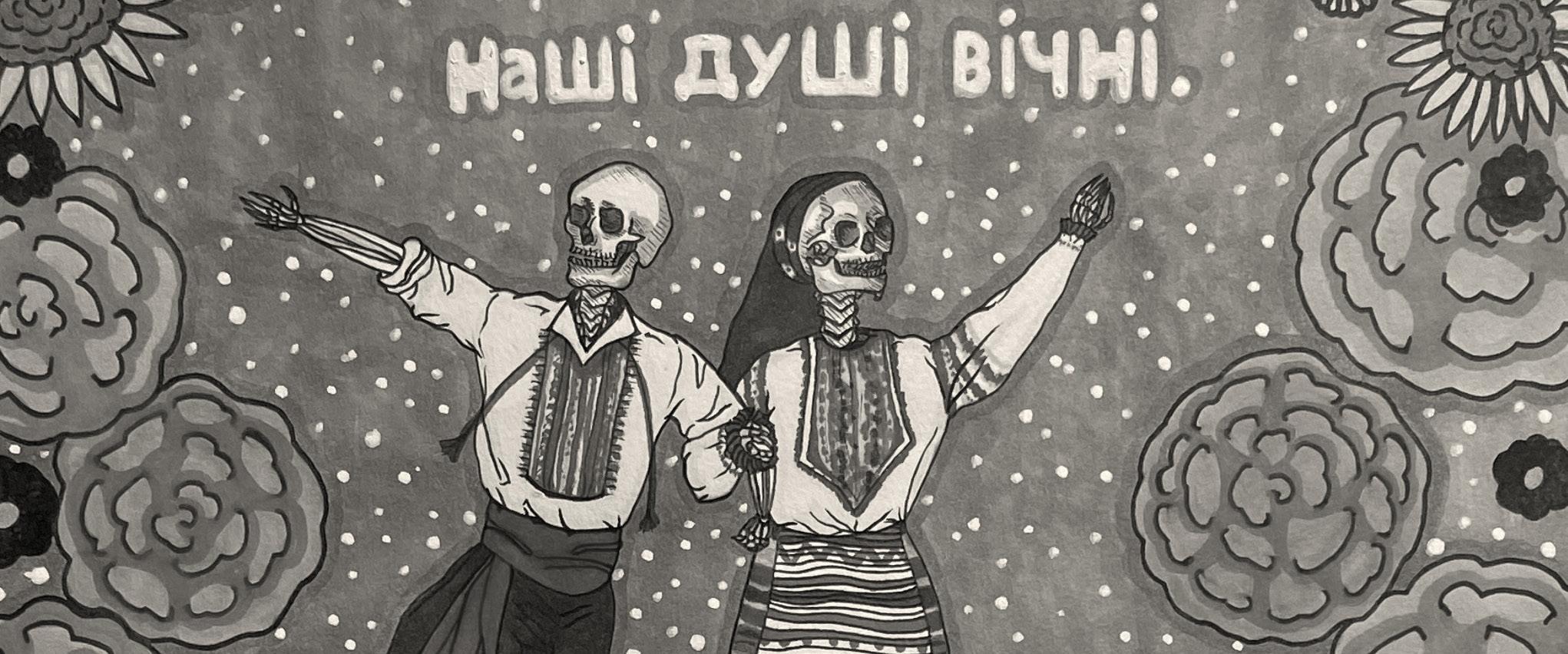
All featured art was photographed from the Día de los Muertos art exhibition on Oct. 23.
See more on page 12!





Friday, October 31,

All featured art was photographed from the Día de los Muertos art exhibition on Oct. 23.
See more on page 12!
Quinn Forssell Staff Writer
On Oct. 16, the annual Great ShakeOut drill was held at Samo at 10:16 a.m. The Great ShakeOut drill is a statewide drill done to prepare students and school staff for any potential earthquake. Earthquakes are common in California, with southern California experiencing about ten thousand earthquakes a year, according to the United States Geological Survey.
In an article published in the Seismological Research Letters by scientists at the USC Dornsife College of Letters, Arts and Sciences, professor of Earth Sciences Yeduha Ben-Zion proposes that preparing for supershear earthquakes has been neglected.
“While California is no more likely to have supershear earthquakes than other, similar regions with large fault systems like the San Andreas, the threat has gone unnoticed for too long. The frequency of these supershear ruptures has been greatly underappreciated,” Ben-Zion said. Supershear earthquakes are a type of earthquake where the ruptures they create are quicker than their seismic shear waves. When they pass their seismic waves, it generates explosive waves that are often compared to a sonic boom. The shaking caused by supershear earthquakes is typically spread farther and is more intense, and can lead to dangerous situations.
Gavin Newsom, California’s governor, has stated that he
believes the Great ShakeOut drill may lead to fewer deaths during earthquakes.
“When it comes to earthquakes, practice makes perfect and seconds can save lives,” Newsom said.
The American Red Cross nonprofit organization agrees with him, seeing the drill as a good way to keep people safe.
“This annual event brings together millions of people worldwide to practice life-saving safety measures for earthquakes. While earthquakes cannot be predicted, preparation is key to minimizing harm. Participating in the Great ShakeOut is a simple yet effective way to practice essential safety actions,” the American Red Cross said on its website.
The potential for these extra-strong earthquakes is all the more reason drills like the Great ShakeOut are important for schools to have. Samo student Jayd Campbell (’29) finds the drill helpful, as it helps her feel better prepared for if an earthquake were to occur.
“I really love the Great ShakeOut because I think it’s really important for safety reasons, so people know what to do in case of emergencies. It makes me feel safer because California is a state where we do get a lot of unexpected earthquakes. It gives me a sense of security,” Campbell said.
While supershear earthquakes are potentially a risk to the residents of California, the Great ShakeOut is a way to help students prepare for when one may strike.
Jasson Martinez (’19), a former Samo student, has returned this school year to Samo to work as an Algebra 1 and 2 teacher. After 6 years away from Samo, he was eager to get back. Martinez had seen himself coming to work at Samo since he graduated from the school.
“I wanted to always come back to Samo one way or another. It didn’t matter for me what kind of job I did. I realized I was leaning towards teaching, so I made a promise to myself that if I completed my teaching degree, then I would try to go back to Santa Monica High School. [What drew me back] had to be the community and how socially acceptable we as a community are,” Martinez said.
Samo was a source of community for Martinez while he was a student, and he wants to help cultivate that experience for the next generation. The diversity and acceptance that Samo has were and are important to him, and he hopes to bring that with him into his classroom and 3 clubs. Martinez specifically wants to follow in the footsteps of his own previous algebra teacher, Ramon Veral. Martinez hopes to be what Veral was to him for his students and support those in his class.
“He was my math teacher, who was Latino, who showed me that it was possible to do it. So that’s what gave me a bit of inspiration as well, to want to become a teacher. I want to be there for students,” Martinez said.
Martinez seems to be doing what he set out to do, according to Bailey Labrie (’28), one of his students.
“[Martinez] is a young teacher, so he can connect more with the students, and that’s really helpful. He knows how the school

The Samohi is a designated public forum for student expression without prior review by school officials in which students make all final content decisions.
The by-lined opinions expressed in the Editorial/Opinion and Entertainment sections and columns are those of the writer and do not necessarily reflect the opinion of The Samohi. Any opinions or views expressed in advertisements do not necessarily reflect those of The Samohi. Not all submissions will be printed and may be edited to conform to The Samohi policy or to meet space restrictions.
works and how other people are. He’s also very supportive. He gives me a lot of help if I ask. If [students] get a bad score on a test or a quiz, he’ll come around and help us out. He’s a very chill teacher,” Labrie said.
During her time in his second period, Labrie has found Martinez’s class to be a place of support and help, as he hoped to make it. His status as a former Samo student has also made Martinez easier for Labrie to relate with, as he understands the student experience.
Martinez seems to be meeting the goals he has set for himself as a Samo teacher, successfully bringing support to his students through his relatability as a Samo alum, just as he felt supported during his time here.

Editors-in-Chief
thesamohinews@gmail.com
Claire Harrison
Liam Sauer
Business Manager
Addie Burns
News Editors Eugene Naruse
Louis Rotgin
Opinion Editor
Leo Lucente
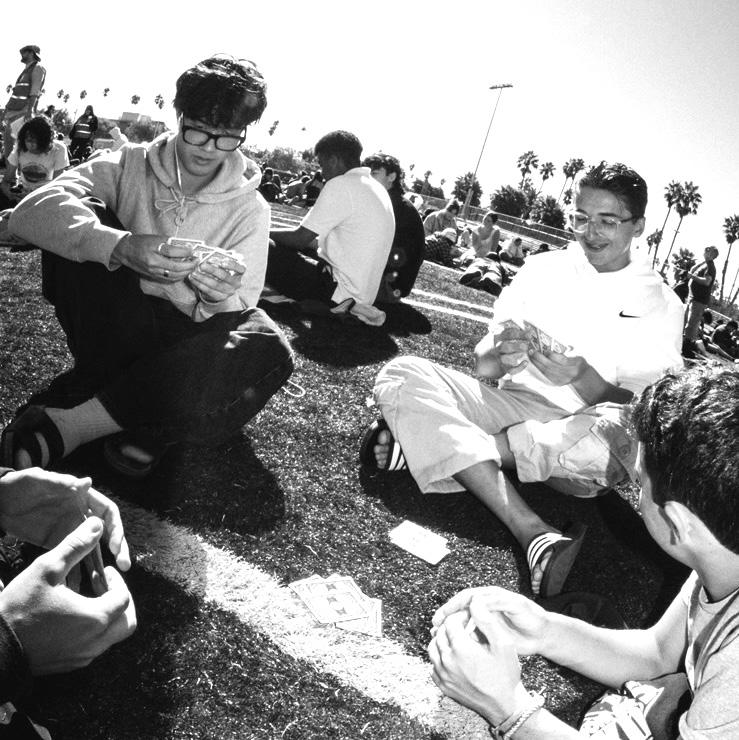
thesamohinews@gmail.com
A No Kings protest took place in Santa Monica at Palisades Park on Oct. 18, from 11 a.m. to 1 p.m., following the original back in June. The mission statement, or manifesto, of the No Kings Movement states that they are against those in power not being held accountable or checked, and that they will not stay quiet.
According to the No Kings Movement website, “We stand against unchecked power. We defend democracy. We reject billionaire con-

Protesters crowd the
trol. We hold leaders accountable. We take action. We will not be silenced.”
The Santa Monica protest was one of over two thousand No Kings protests across the globe, which totaled a little under 7 million participants. While the number of people who attended the Santa Monica protest is not known, the Palisades Park was packed with people.
Student Life Editor
Imani Toler
Centerspread Editor
Maxine Kehoe
A&E Editor
Athena Barefoot
Sports Editors
Laurel Cohn
Addy Fiore
Photo Editor
Manny Lopez
Art Editors
Florence Fraser-Macduff
Sara Polster
Copy Editors
Koi Lerner
Olivia Stephansen
Digital Editor
Emma Godfrey
Community Liaison
Arata Sakamoto
Faculty Adviser
Elizabeth Stapleton
Attendees brought drums and led chants, and some participants showed up in inflatable costumes, dressed as animals like chickens, ducks, and unicorns. People of all different ages were present, including Samo alumni and multiple current students. such as Finn O’Brien (’28).
“There were definitely people from all walks of life. There were a lot of very cool posters. It was pretty enjoyable overall,” O’Brien said. Another Samo student, Juliette Tabesh (’28), was there to fight against the current restrictions on abortion.
“I’m definitely passionate about abortion issues. As a woman, if I had to deal with that, it’d be my worst nightmare. I haven’t personally felt anything super important in my life change, but I know that for a lot of people that isn’t true, and I have the opportunity to go to these protests and to speak my opinion, and that’s important.” Tabesh said.
Tabesh wants to protest to have her voice heard, and finds doing so to be valuable, as not everyone has the privilege or ability to do the same. O’Brien, on the other hand, was there to protest against President Trump’s approach to the judicial system.
“I was protesting how Donald Trump has been ignoring court mandates and the rulings of the Supreme Court, and how he’s trying to block people’s ability to due process. If anyone is affected by the loss of due process, everyone could be,” O’Brien said.
They want these things to change, and for many, protesting is a way of trying to insight that.
No date has been set for the next No Kings protest, if another is to occur.
thesamohinews@gmail.com
Staff Writers
Ashley Ballantine, Ileana De La Cerda, Lily Edwards, Quinn Forssell, Otem Free, Sophia Freidman, Jack Goldberg, Ramona Häendel, Devyn Hamilton, Jake Phasavath, Yaretzi Presa, Anna Ross, Arturo Singer-Portnoy, Audrey Stephansen, Ashley Tan, Jefferson Tinus, Hope Wang, Kira Willinger
Sports Reporters
Opal Feves, Scarlett Goetz, Leo Mooney, Belle Walker
Arturo Singer-Portnoy Staff Writer
A ceasefire between Israel and Hamas took place on Friday, Oct. 10, marking the first sustained pause in fighting after two years of conflict in Gaza. Under the agreement, Israeli troops began withdrawing from sections of the Strip while both sides exchanged hostages and prisoners. Aid has also now begun to flow into Gaza in increased amounts, delivering essential supplies like food, water and cooking gas for the first time in months.
The Israel-Palestine conflict began in the aftermath of Israel’s establishment in 1948 and has been marked by wars, uprisings, and failed peace talks. In the decades that followed, Israel faced armed conflicts with the Palestinian Liberation Organization (PLO) and other factions of the Muslim

Brotherhood. Hamas, an Islamist group designated as a terrorist organization by the United States, was founded in 1987 but came to power in 2007 after a violent civil war with Fatah, a Palestinian nationalist group.
On Oct. 7, 2023, Hamas launched a major, coordinated surprise attack from the Gaza Strip by land, sea and air. The incursion, which targeted innocent
civilians, killed approximately 1200 people and took an additional 251 hostage, marking the beginning of the current Israel-Hamas conflict. Since then, two failed ceasefires have taken place in November of 2023 and March of 2025, the details of which included Hamas’s demand for a permanent ceasefire and the full withdrawal of Israeli forces, repeatedly rejected by Israeli Prime Minister Benjamin Netanyahu.
The day after the deal was made, 20 Israeli prisoners were released from captivity in exchange for approximately 2,000 Palestinian prisoners and detainees. This number includes roughly 250 prisoners serving life sentences for serious crimes including terrorist attacks, and more than 1700 Palestinians who were detained in Gaza during the war and held without charge. An objective for Israel now involves the return of the bodies of the deceased hostages remaining in Gaza. As of Oct. 21, the bodies of 13 hostages are still being held in the Gaza Strip, buried under thousands of pounds of rubble, and some may not be located at all.
Alongside captive exchange, Israeli forces are under a partial withdrawal and redeployment to “agreed-upon deployment lines.” Concurrently, Hamas combatants have redeployed to areas vacated by Israeli troops.
Following the ceasefire, tens of thousands of displaced Palestinians are currently returning to destroyed areas of Gaza, particularly in the north and Gaza City, only to find the areas largely reduced to rubble. In an interview with The Guardian, Gaza resident Abdel Fattah al-Kurd described the stark difference between the city before the current conflict and what remains today.
“The city looks completely different, as if it is no longer the Gaza we once knew … Almost all of the houses are destroyed … the streets blocked,” Fattah al-Kurdi said.
The Hamas-run Gaza media office has stated that
Israel has violated the ceasefire 47 times and killed 38 Palestinians. Israel has also kept the Rafah crossing (a major aid corridor) closed “until further notice,” citing Hamas-linked failures in the compromise. Palestinian authorities say this is an abuse of the ceasefire terms, since humanitarian access was supposed to increase under the ceasefire.
Hamas has also committed violations, including public executions of Palestinian civilians after claiming they had collaborated with Israel. On Oct. 19, the Israeli Defense Forces reported that two Israeli soldiers were killed in Rafah and accused Hamas of firing an anti-tank missile and gunfire, calling that an infringement on the peace deal.
The famine now gripping Gaza is widely described as man-made. This is partially the result of restrictions imposed by Israel on the entry and distribution of humanitarian aid during the war. Reports from the U.S. Agency for International Development have also accused Hamas of stealing aid and diverting relief supplies meant for civilians.
Despite the ceasefire, the humanitarian situation in Gaza remains critical, with aid groups warning that food, water, and medical supplies are still scarce. According to the United Nations Office for the Coordination of Humanitarian Affairs (OCHA), thousands of families are still sheltering in schools and in makeshift camps in the south.
OCHA has stated that aid delivery, while having somewhat improved, remains far below what is needed. By Oct. 13, about 949,000 meals had been delivered and water access had improved slightly, yet hospitals continued to function only in part or not at all. Fuel and sanitation systems are also severely damaged and whole neighborhoods are inaccessible due to debris and unexploded ordnance. Head of the Palestinian NGO’s network, Amjad Al-Shawa, told Al Jazeera that assistance remains insufficient.
“The aid that reaches Gaza goes directly to the
most vulnerable families. But it remains insufficient. Almost everyone in Gaza now depends on humanitarian assistance after a full year of Israeli bombardment and siege,” Al-Shawa said.
Families of the hostages played a significant role earlier in shaping public pressure within Israel for a ceasefire and urging for the return of their loved ones. Their advocacy added urgency to the negotiations that followed.
The United States’ involvement in the peace deal has been central, as the Trump administration takes credit for facilitating talks between Israel and Hamas. The ceasefire was arranged and mediated by the United States, with Egypt and Qatar playing key roles in facilitating indirect talks between Israel and Hamas. Speaking to reporters aboard Air Force One, President Trump framed the agreement as a turning point in the conflict.
“Israel, with our help, has won all that they can by force of arms. Now, it’s time to translate these victories against terrorists on the battlefield into the ultimate prize of peace and prosperity for the entire Middle East,” Trump said.
200 U.S. troops have also been deployed to Kiryat Gat, a city in southern Israel approximately 20 miles from Gaza. One anonymous senior White House official said in an interview with Reuters that no U.S. soldier would be permitted to enter Gaza as they were there to help prevent conflicts and establish a “joint control centre.”
Amid the political and military developments, Samo student and active Jewish community member Eli Tobel (’27) shared optimism about tensions beginning to ease and communities starting to heal.
“I mean, there’s definitely been a lot of rise in antisemitism and Islamophobia. I really hope that the swelling of that stops. I mean, hopefully, now that the war is over, it’ll start to drop back down. Who really knows what the future holds?” Tobel said.
thesamohinews@gmail.com
Jack Goldberg Staff Writer
The government shutdown is set to enter its fifth week following Congress’s failure to enact a budget plan for October and beyond. While Republicans hold a majority in both chambers of Congress, the party lacks the needed 60 votes for any bill to pass through the Senate, giving Democrats some negotiating power during the shutdown. Democrats and Republicans blame each other for the current government shutdown, with stalled talks and no plans for compromise in sight.
The expiring healthcare act is the primary issue currently blocking a bill to fund the government. The Affordable Care Act (ACA) is a healthcare reform law passed in 2010, and the act aims to make health insurance more affordable by implementing coverage standards and expanding Medicaid. However, with the act set to expire this year, millions of Americans are expected to face higher premiums starting as soon as 2026. Democrats seek an extension of the ACA to be included in any bill to reopen the government. Additionally, many Democrats want to see a reversal of Trump’s cuts to Medicaid, a program used by millions of elderly, disabled and low-income households. However, Republicans hope to simply reopen the government and leave the ACA as a topic for discussion down the road.
Mike Johnson, Republican Speaker of the House, addressed the recent shutdown and his views on what needs to be done during a Fox News inter-
view on Oct. 12.
“We’re barreling toward one of the longest shutdowns in American history unless Democrats drop their partisan demands and pass a clean, nostrings-attached budget to reopen the government and pay our federal workers,” Johnson said.
Chuck Schumer, Democratic minority leader in the Senate, spoke on the Senate floor on Oct. 16, calling out Republicans over the growing healthcare crisis.
“The ACA crisis is looming over everyone’s head, and yet Republicans seem ready to let people’s premiums spike by tens of thousands. Again, that’s who the hostages are: the American people who need healthcare relief and who are demanding healthcare relief,” Schumer said.
Amy Bisson, an AP Government teacher at Samo, notes the uncompromising attitudes in Congress.

“I do believe that the Republicans had no intention of ever compromising. The bill was never opened up for compromise. I think that a big part of our government is compromising, and it’s not always majority rule. It’s majority rule, while protecting minority rights and I would say the Republicans are failing in that area,” Bisson said.
The government shutdown entails a furlough that sees tens of thousands of government employees not receiving pay until Congress can agree on a new funding plan. This has massive implications for federal employees who are now without a job or paycheck for an undetermined amount of time. Even amidst the shutdown, essential workers such as those in the Transportation Security Administration (TSA) and Air Traffic Controllers are still required to report to work without pay. However, it is common for workers to call in sick en masse to avoid working without pay. On Oct. 6, for about 6 hours, the Hollywood Burbank Airport reported to have zero Air Traffic Controllers on duty. At airports such as LAX, flight cancellations will become much more frequent until workers are paid once again. On Oct. 25, flights departing LAX were halted due to a staffing shortage at a Southern California air traffic control facility.
The Trump administration has further complicated the situation as it dabbles with the issue of back pay, which reimburses federal employees for the hours they worked during the shutdown. The Trump administration has admitted there are talks of removing any back pay for the time many are
spending unpaid at work. This puts more pressure on Congress to find an answer, as it fuels outrage and incentivizes more workers to call in sick rather than work for no pay.
The Supplemental Nutrition Assistance Program (SNAP), the largest federal program to fight food insecurity in the United States, is also under pressure. SNAP, more commonly known as food stamps, offers millions of Americans financial aid to purchase groceries. The Department of Agriculture posted a notice on its website that SNAP benefits will not be issued for the month of November, leaving roughly 42 million Americans without financial assistance for food. 25 states, including California, have sued the Trump administration over the freezing of these food stamps during the shutdown. The lawsuit alleges that the decision to freeze food stamps for millions of people is unlawful and strips away people’s protection from food insecurity.
“I think both sides are gonna have to answer to people who are not gonna have enough money for food or for gifts for their children. So I think it’s gonna be a combination of everything. I think [it’s more than] just the air traffic controllers. It’s people not having enough money to have a Thanksgiving dinner, or not being able to get enough food to eat for Thanksgiving. That’s gonna put a lot of pressure on both parties to be the party that somehow makes it work,” Bisson said.
thesamohinews@gmail.com
Gov. Gavin Newsom this month signed Assembly Bill (AB) 628 as well as Senate Bill (SB) 79. The bills are part of housing laws that Newsom has passed in an effort to provide more housing, lessen homelessness and create more affordable housing for the state. AB 628 was proposed by Assembly member Tina McKinnor (D-Inglewood) in February and will go into effect on Jan. 1, 2026. AB 628 requires landlords to provide a working refrigerator and stove for all leased homes. The bill specifically states that broken refrigerators or stoves must be fixed or replaced by the landlords, unless the tenant can provide their own. The bill also recommends that electricity, water and heat be maintained, aiming to improve living conditions for residents who rent.
Assembly member Scott Wiener (D-San Francis-
co) proposed SB 79 in January 2025 to make zoning laws less restrictive, and the bill is set to go into effect on July 1, 2026. SB 79 was primarily backed by the organization ¨Yes in My Backyard¨ (YIMBY), a group that pushes for more housing. The bill will override previous zoning laws and promote denser, multi-family housing developments near transit-oriented development (TOD) zones. These zones include any developments near high-frequency public transportation, such as trains and subways, and the goal is to increase affordable housing units in California, especially near transit stops for lower-income and working communities. However, SB 79 drew controversy among some California officials, including Los Angeles Mayor Karen Bass and State Assembly members. In a speech on Sept. 11, Assembly member Rick Chavez Zbur, who represents Santa Monica and Beverly
Hills, expressed his opposition to the bill.
“A misguided solution to a real problem is not a real solution. SB 79 is not the answer to California’s housing crisis,” Zbur said.
Opponents of the bill, including Zbur, argued that SB 79 would erode control over local developments in their cities and affect low-income, as well as single-family housing neighborhoods by building multi-family units.
Carl Hansen, a former member of the Santa Monica Housing Commission and the current co-chair of Santa Monica Forward, an organization that prioritizes progressive policies including
affordable housing, argued in support of the new bill.
“As we think about growing our cities, it is also critical to think about how people will move around. TOD is a good strategy to ensure new development generates fewer CO2 emissions, traffic, and parking challenges from the transportation needs of new residents,” Hansen said.

Nathaniel Acker, an AP Government and Politics teacher at Samo, further emphasized the goal of the bill.
“The great hope is that it will increase affordable housing for Californians and potentially lower the cost of housing by having a much larger supply,” Acker said. These initiatives are being enforced in high metro areas like Los Angeles, Orange County, Santa Clara and other select cities across California.
thesamohinews@gmail.com
Devyn Hamilton Staff Writer
On Nov. 4, registered voters will go to the polls and vote on Proposition 50 (Prop. 50), formed by California Governor Gavin Newsom. Prop. 50 temporarily redistricts the state of California, switching five Republican districts Democratic. This was done in response to House Bill 4 (HB 4) in Texas, which flipped five Democratic districts Republican.
HB 4 allowed for a five-year early redrawing of the congressional maps in Texas. Traditionally, congressional maps are drawn every decade after a census is taken of the characteristics and quantitative size of citizens in each district. The census includes ethnicities, sexualities, economic status, genders and political parties. Once this census is taken, the maps are drawn and representatives are voted in within the district they reside in by eligible residents.

Currently, the House of Representatives has a split of 219 Republican seats to 214 Democratic seats, with a vacancy of two. HB 4 allocates five more Republican seats for the upcoming midterm elections by redrawing currently Democratic districts to have Republican majorities. For example, Austin, Texas, is currently split into two districts. With the proposed HB 4 maps, it is now concentrated into one district, decreasing the number of Representatives for this Democratic district by half. HB 4 would therefore give Republican representatives a numerical
advantage in the House. Prop. 50 combats this addition by redrawing five currently Republican districts into Democratic districts on an interim basis, maintaining the current partisan ratio in the House.
Benjamin Schneer, a professor of public policy from Harvard Kennedy School, was interviewed on HB 4 by the Harvard Kennedy School Explainer. Schneer stated that the way in which Texas was redistricted is partisan involvement–in this case, gerrymandering–because of where they locate Democratic citizens within districts.
“Another telltale sign of gerrymandering is a map with districts reaching into areas that tend to be suburban or rural… and then reaching into cities and picking out smaller numbers of Democratic voters in the cities,” Schneer said. “That’s known as cracking: taking voters from one party and moving them into a district where there are not enough of them to win in the district.”
HB 4 was put into place by Texas Governor Greg Abbott as a means to represent the large Republican population in the state. In approving HB 4, Governor Abbott mentioned this rationale for the bill and its importance.
“I congratulate… the Republican members of the Texas House of Representatives for passing congressional districts that better reflect the actual votes of Texans,” Abbott said.
Following this action by Governor Abbott, Governor Newsom responded with Prop. 50 to combat the new Republican representatives in Texas. Newsom also spoke of his belief that passivity in the Democratic Party needs to end.
“California will not sit idle as Trump and his Republican lapdogs shred our country’s democracy before our very eyes,” Newsom said. “This moment calls for urgency and action–that is what we are putting before voters this November, a chance to fight back against his anti-American ways.”
While many Democrats have supported Prop. 50 and felt that HB 4 gave Republicans an unfair advantage in the House, President Trump has argued to CNBC that the Republican Party deserves five more seats in the House.
“...we have an opportunity in Texas to pick up five seats–we have a really good governor [in Texas] and we have good people in Texas. And I won Texas–I got the highest vote in the history of Texas… so we are entitled to five more seats,” Trump said.
A Republican majority would likely benefit President Trump’s governmental agenda, as the representatives in the Republican Party have a greater chance of voting on laws in President Trump’s favor. Franklin Thomas (’27) shares that he feels the redistricting came directly from President Trump’s requests.
“I think [Texas] faced considerable pressure from the Trump administration just based off of his posts on social media,” Thomas said. “There is definitely a large amount of pressure from the Republican party to redistrict in order to get more seats.”
Prop. 50, if passed, would temporarily redraw California’s congressional maps in preparation for the midterm elections next year. HB 4 was passed through the Texas State Legislature without a vote from the general populace. The new maps, drawn out by the California State Legislature, are what California citizens will be voting on in Prop. 50.
The maps create larger districts in suburban areas. According to the Pew Research Center, a non-partisan organization, rural voters have developed from an about even split in 2000 to a 25 percent lead by the Republican Party in 2024. This means that a larger rural district, instead of the current, relatively smaller rural districts, would put more Republican Californian voters in the same few districts, giving them less power over the House, similarly to what was done in Texas to Democrats via HB 4.
As the election date is unusual for a statewide vote–given that it is happening in an odd-numbered year–voting-eligible students at Samo are able to participate in their government a year early. Shayl Khatod (’26) discussed his conflicting opinion on Newsom’s proposition.
“I honestly really dislike the legislation… people should have the power to define their own districts, but I’m also voting yes because everything’s so partisan right now,” Khatod said. “Morally it pains me but this legislation is important because it prevents Republicans from passing other great, big, beautiful, bad, terrible bills.”
He went on to emphasize that he hopes his fellow voting seniors will partake in the election.
“100,000 percent vote. Please vote. Yes, or no, or vote Republican, or Democrat. Yeah, just vote,” Khatod said.
thesamohinews@gmail.com
Sophia Friedman Staff Writer
The Santa Monica Behavioral Health Wellness Center, a non-profit planned to open early in November, was to replace senior housing on the four hundred block of Ocean Avenue. Developed by St. Joseph Center, the project was supposed to act as transitional housing for people facing problems concerning mental health and homelessness.
On Oct. 27, Los Angeles County Supervisor Lindsay Horvath announced the termination of the project altogether. The lack of community awareness, coupled with the concerns of safety, prompted the county supervisor to proceed in a way that would maintain the trust between the community and county.
Upon its announcement, the project faced severe backlash from different parts of the Santa Monica community.
One of the primary concerns from the community was the lack of transparency from the city and county. Santa Monica resident Matt Goldenberg explains that this lack of transparency had led to a struggle with trust between the community and the city, and the need for a plan that people could
understand.
“I was surprised because it sounded like there hadn’t been the normal public disclosure that we would’ve expected,” Goldenberg said.
The project was planned to be located in one of Santa Monica’s most exclusive neighborhoods. Its location would be in proximity to elementary schools, as well as Palisades Park, an area where residents and children frequent. This aspect of the project, along with the potential open-door policy, also raised concerns of safety.
Samo student Andie Ernst (’28) explained how the project’s location could pose potential safety risks.
“Considering I live close to Ocean Ave., I think the project would bring more homeless people to the area and make me feel unsafe,” Ernst said.
On Oct. 14, Horvath announced a ‘pause’ on the project. Horvath and the St. Joseph center decided to hold off on proceeding with plans after receiving complaints from the community due to the lack of input.
“The county had been planning this for months and didn’t communicate with the neighborhood until two weeks before it was planned to open, and so the question became why, if this was going to
be such a successful and wonderful program, why wouldn’t you disclose that early?” Goldenberg said.
Another institute run by the St. Joseph Center, The Manor, located on Pico Blvd., has drawn similar concerns. It is said to have frequent police visits and screaming, causing residents to avoid walking near the site. To help address concerns, the St. Joseph Center maintains a hotline for people to contact if they have any questions.
Samo Student Sadie Gryczman (’26), president of Student Wellness Advisory Group (SWAG), explained how the opening of this initiative could have benefited the community.
“Mental health is a very prevalent issue, and giving these opportunities to people with mental health issues is really important. It’s creating a safe space where people can get the care they need to build some stability,” Gryczman said.
This project was developed by the St. Joseph Center, in collaboration with the property owner, Leo Pustilnikov. Serving as a former senior housing development, Pustilnikov offered the space to the Center in 2004. It only received permits from the county as of early October, as well as sufficient funding from grants. The project was being funded by the Los Angeles County Department of Mental
Scarlett Goetz Staff Writer
On Aug. 30, 2024, Gov. Gavin Newsom signed Senate Bill 1053, a law that will ban all plastic bags at convenience and grocery stores starting Jan. 1, 2026. After years of failed attempts to mitigate plastic pollution, the new law closes the 2014 bag ban’s loophole to finally eliminate plastic bags in California.
One of Samo’s environmental clubs, Team Marine works to make a change in local pollution through education, activism, and community action. This student-led club in the past influenced the Santa Monica City Council to pass the plastic ban law in 2014, and they are currently taking data from grocery stores around Santa Monica to evaluate the success of this new plastic ban. Carla Sinecka (’26), co-leader of Team Marine expresses her eagerness to see how the new law coming in January will make a difference.
“I’m excited to see what kind of change it makes,” Sinecka said. “We are most certain it will be positive.”
While in 2014 California passed the first statewide plastic bag ban in the country, the bill had unintended consequences that further contributed to California's plastic waste problem. The bill in 2014 banned thin, single-use plastic bags at grocery stores, pharmacies, and some retail shops and allowed the stores to start selling thicker
plastic bags, which were labeled as reusable. According to Oceana, an environmental group that collects stats on pollution, this not only doubled the overall plastic bag waste due to the increased weight of the thick bags, but also was extremely ineffective in helping control plastic pollution.
In their place, stores are encouraging shoppers to bring reusable bags or pay a minimum fee of 10 cents per paper bag at the checkout. Supporters of the new law view it as a significant step forward in protecting the country and our environment. However, the higher cost of alternative packaging materials is a partial concern, particularly for small businesses. Retailers found selling plastic bags after the ban takes effect will be fined up to $1000 to $5,000 for repeated offenses.
Over the years, the continued use of thicker plastic bags has taken a serious toll on the environment, especially seen locally. Benjamin Kay, a science teacher at Samo and advisor for Team Marine, has reported seeing numerous thick-film plastic bags in the storm drain on Pico, just blocks away from the Samo campus. Despite the existing ban on thin film bags, the thick film ones are becoming just as problematic.
“And there's thick film bags in the storm drain, just like there used to be thin film bags back in 2014. In other words, plastic is now getting debatably just as bad as the thin film ones, each of those thick film bags being several times the weight of a thin film bag,” Kay said.
As plastic pollution continues to affect our oceans, wildlife, and
Health under Prop 1.
In terminating the project, Horvath has decided to work with the St. Joseph Center to look for alternative locations that would be better suited to the project, while preserving the relationship between the county and the Santa Monica community. Horvath shared her thoughts on the situation in a statement to the Santa Monica Daily Press. “When a project moves forward without community awareness, it erodes trust. In this case, that trust has been broken, and the community is right to be frustrated,” Horvath said.

thesamohinews@gmail.com

human health, the plastic bag ban coming in 2026 represents a
attempt to reduce plastic
in California. With
from
Marine, data collection and outreach will help track the success of the ban as well as spreading awareness about the harmful pollution. The next few years will show whether California’s new law can make a difference towards a clean and sustainable environment.
Liam Sauer Editor-in-Chief
Throughout high school, I imagine we have all had the idea pop into our minds that school feels like a punishment. Sitting in hour or hour and a half long classes, oftentimes barely moving or speaking, is for many, simply torture. And worst of all, is that the one escape we’re given to recharge and socialize is lunch: a period that shockingly amounts to approximately as little as eight percent of our total school day.
Samo students, the majority of whom are at school for seven hours every day, are only afforded 35 minutes of lunch. Shave off the 10-15 minutes it can often take to wait in abhorrently long lunch lines, and many students are left with essentially no time to actually recuperate from the hours of school they have just, and subsequently will endure.
This issue is not just that this is undesirable–yes, no one wants to be cooped up in a room for a third of their day–but that it is completely unhealthy and counterproductive to proper learning.
Schools across the country collectively ignore this fact, that time outside, and breaks for students, are of essence to our development.
There is a laundry list of data to support this. Even simply getting extended sunlight throughout the day has been associated in
countless peer-studies with less risk of developing almost every life threatening disease, increased mental health, better sleep, and essentially bettering every ailment that is touted as “infecting Gen-Z”.
Policymakers and educators talk about the inverse dangers of adolescents being stuck alone inside on their devices, but are blindly ignorant to the fact that they have an actionable way of challenging this problem- giving us actual time outside where we can socialize during the most active part of our day.
The core argument against this increase in lunch is based in fallacy. There is this idea that schools have zealously stuck with, that increased class time automatically translates to increased learning. The fact is, everything we know about memory consolidation and comprehension is contrary to this.
In a 2025 meta-analysis published in Psychonomic Bul letin and Review that analyzes the results of 37 peer-re viewed studies, researchers determined the importance of wakeful rest (e.g. breaks like lunch), and the lack thereof, in actually being able to retain and properly uti lize information.
The study clearly disputes this idea, that the more material time effectively packed into a school day, the more students will learn. In like manner, giving students lunchtime isn’t just a necessity for their nutrition, but for adequately making sure they are taking in
the information they are learning.
I understand that schools by law must meet a certain amount of class time. But the administration also can’t sit idly by as we, in what may be the most formative years of our lives, are depleted of integral social time, with a break that barely covers a fraction of our stressful days. Schools like Ardunel High School in Maryland, introduced a 50 minute lunch period, and were able to incorporate it in such a way it noticeably increased schoolwide productivity. I’m not here to claim that it is easy to magically reschedule Samo into giving students a lunchtime free for all. But I will say with a doubt that if the administration really wants to benefit their students, they will figure out a way in which they can give students a longer lunch our education and wellbeing.
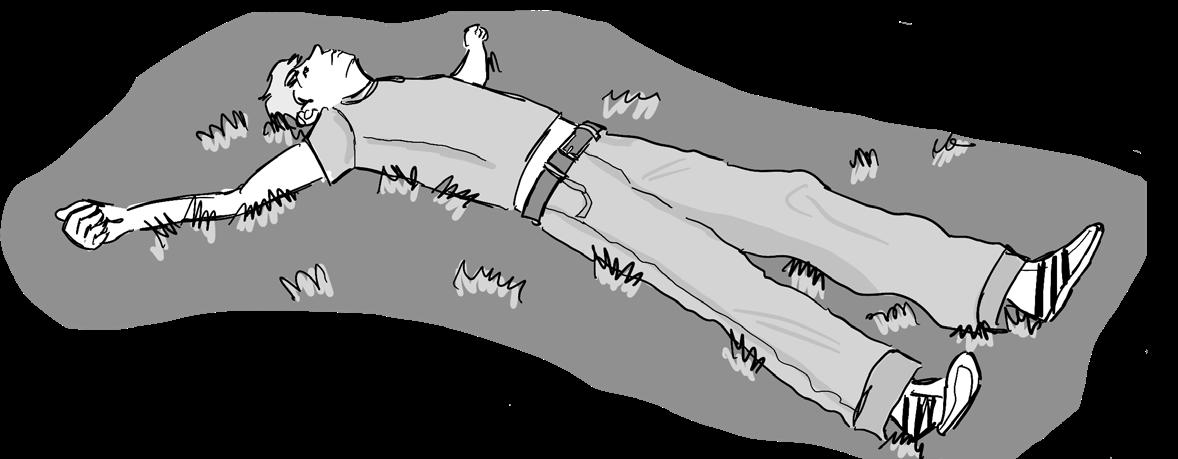
samohinews@gmail.com

Dear Ramona,
After seeing your last article in the paper I’ve been inspired to share my own problems in hopes you can give me some sage advice. For a long time I’ve had this feeling—a sort of pit in my stomach—every night or moment alone that maybe my friends and people in general don’t actually like me much at all. That they find me too talkative, unfunny, or too sensitive. More specifically I feel like a lot of my friends don’t view our relationship the same way I do or hold it with such importance. I try to make an effort to be available but I feel like this isn’t really reciprocated. I just worry that in reality my importance in their life doesn’t equate at all and I’ve been misinterpreting things. That us being friendly classmates who I think get along well are actually nothing more than that. Just classmates. In larger groups I always feel like I’m butting in, like I’m not truly a part of the conversation or am always the one that needs to catch up on what everyone else is talking about. I feel like I’m missing something everyone else has, that bond they all share with one another for whatever reason just doesn’t feel like it is the same with me. I feel like if you put a bunch of people they knew in a room and told any of my friends to pick someone it wouldn’t be me. And that’s fine in the grand scheme of things but it’s something that bothers me. Who would pick me in a room full of people? I can’t really think of anyone. I feel like I know they have more important people in their lives other than me. I understand, but it doesn’t make me feel very good about myself. From,
Your very anonymous and socially anxious reader
Dear my very anonymous and socially anxious reader, It would make it very easy for me to validate your feelings by telling you that you are in fact too talkative, unfunny, or too sensitive, but unfortunately you have given me no evidence that you are any of these things. I can’t guarantee it, but from what I’ve seen most people will tell you if they didn’t like something you did, either that or they will make it very clear without directly telling you. It sounds to me that you overthink the idea of yourself in your friends’ minds, instead of just letting yourself exist and letting the stability of your friendships follow. On a more disappointing note, sometimes finding friends that you really connect with can be a long, tricky, and tiring process, but fostering the friendships you already have is an entirely underrated thing to do. Continue asking your current friends for plans, the worst they can say is no. As Wayne Gretzky once said, “You miss 100% of the shots you don’t take,” or in your case, you miss out on 100% of the plans you don’t try to make. You aren’t wasting anyone’s time by asking them for plans, nor is it by any means offensive that you did ask to hang out, so stop getting in your head so much about whether or not people want to hang out with you, and let them make that decision themselves.
If you take anything from this, let it be this. Even if you ARE too talkative, or sensitive, or unfunny to one person or another, it doesn’t mean you are those things to everyone. These traits you claim to have are completely subjective, and I’m not even just saying that to be nice. There are plenty of comedians I find unfunny, but clearly some people disagree with me because they are professional comedians with careers in comedy. Many people have told me I’m too talkative, and yet I still have plenty of loving relationships. It’s going to be just fine, you will find those people that would pick you in a room, even if it takes time, but for now, you can pick yourself in the room.
Sincerly, Ramona
*TobefeaturedinafutureissueofRamonaRespondsemailRamonaatrjh@smmk12.org*
Devyn Hamilton Staff Writer
The only justifiable way to make up for the psychological effects of rape on a victim is to remove a rapist’s ability to commit that crime altogether. Chemical castration is the practice of using hormonal chemicals and anti-androgens to shut down testosterone production. This treatment renders a patient incapable of having children, as well as removing their genetic capacity for sexual activity.
This is the perfect punishment for convicted rapists. The treatment isn’t about whether or not a rapist deserves to have kids–it’s about whether or not a kid deserves a rapist as a parent, and the answer is no. The treatment also makes a patient’s libido decrease significantly.
While this is a severe punishment, many countries have already adopt ed this procedure for certain sexual offenders. Indonesia, Madagascar, Poland, Russia and South Korea in volve chemical castration for seri ous or repeat rape charges. In some places, such as Argentina, the United Kingdom, Germany and some states in the United States, chemical cas tration is a voluntary treatment for offenders. In these cases, the procedure often comes as a part of the negotiation deal for parole. Some argue that this treatment is nonconsensual no matter what, be cause in cases of negotiation deals it’s a choice between time in jail and cas tration. Since it’s under strict terms, the consent given by an offender isn’t truly consent. But to be frank, rapists shouldn’t
need to give their consent for this type of thing. A survivor of rape didn’t give their consent, either, so it’s really fitting that a rapist doesn’t have to for the procedure to take place. Another concern is the brutality of the treatment. It’s argued that chemical castration is a dehumanizing procedure–which it is. Rape is also a dehumanizing action, which makes this treatment spoton in its justice. In fact, it’s less dehumanizing as offenders will be put under anesthesia and won’t feel or remember any pain from the procedure. The same can’t be said for rape survivors. With these justifications in mind, Bella Gulko (’27) describes why it’s a fair punishment.
“Rape is a really serious crime and it can cause a lot of emotional traumatic distress within a person. It’s definitely a really horrible topic,” Gulko said. “I don’t think that the sentence right now is as harsh as it should be because of that psychological age that it causes… I think [castration] is a great

One thing can be said about this procedure, however, that has hardly been mentioned, which is that chemical castration has been used before as a tactic applied to eugenics. Therefore, this punishment should go through several levels of superiors to ensure that there is no a ruling for chemical castration. It’s not this “chemical castration to all, and to all a good of course not. However, in cases where there evidence against the accused, it is the correct action to take. It’s insane that some legislation requires the convicted to be a repeat offender to consider the procedure. Why wait? Therapy, yes; jail, yes; castration, also yes. No matter the gender of either rapist nor survivor, it’s a fitting punishment. In the case of a female offender, the treatment is the same hormone therapy used to treat certain breast cancers. They decrease sex drive in women and have the same overall effect as chemical castration does on male of-
fenders. In some cases, the procedure for female rapists is ovary removal. Rapists are statistically more likely to be men, no matter the gender of the survivor, according to a report in 2021 from the United States Sentencing Commission. In this report, they found that 93.5% of total perpetrators of sexual assault in 2021 were male. If the concern is consent, why should a demographic that is largely male have to give their consent while a demographic that is largely female has that right stripped away from them? This sudden outrage at a lack of consent is honestly more sexist than activist.
All issues surrounding this topic have to do with the humanity of it all. Rape is among some of the most brutal and dehumanizing crimes that can be committed against any single person. Nobody should be concerned about the humanization of a serious rapist. To commit that crime against another human being takes a tremendous lack of empathy which should be reflected back onto the perpetrator at the trial.
Chemical castration shouldn’t be the default for rapists, of course, nor should it be the only response in a rape crime. It must be mixed with psychological treatment to both the victim and the assaulter. The deeper drives of the crime of rape–power, control and anger–must be addressed. It has to be monitored and the case must have strict guidelines that make castration the truly correct response to the rape. The ultimate concern should be watching what demographics of people are sentenced to this procedure; people should be watching to make sure this doesn’t devolve into pure eugenics. However, the fact that opposers to this procedure haven’t spoken on that monitorization once is extremely telling. The fact is, opposing this treatment has nothing to do with human rights, only male rights. It’s not about humanity if the only demographic that’s focused on is men. Chemical castration for rapists should be implemented globally as a punishment–give them the same treatment they give their victims.
Ramona Haendel Staff Writer
In the summer after seventh grade, my social media-hating parents allowed me to download one social platform, Twitter. Both of my older siblings had done the same and encountered very few problems. My parents’ idea was that Twitter would not do any harm to my self-esteem, as Instagram or TikTok would, because the platform was not engineered to make young people feel bad about themselves and spend money. And they were right. Despite wasting a lot of time on Twitter and becoming a somewhat judgemental cynic at 13 years old, my time on the platform didn’t actually damage my confidence, so, ultimately, my parents suc ceeded in their goal to protect my pre-teen self-esteem.
The only problem with this plan was that the fall in confidence my parents worried about was misguided. It didn’t take long be fore I became hateful–consuming disinfor mation and gaining a deluded view of the world. I believed that what I saw on Twitter was the strict reality of life. Lies spread on the platform out of pure malice or depravity did not seem like lies to me. I had not yet been able to grasp that some people weren’t entirely good-natured and fabricated infor mation either for personal gain or, incom prehensibly, purely for amusement. The case for 13-year-old me wasn’t that I didn’t know what to believe, I had never learned that there was information not to believe. Despite my parents’ advice, my presence on social media only grew. I would waste hours, blindly scrolling through thousands of Instagram reels, letting them strip me of my self-respect and individuality. I had no way to filter the truth, and so my self-confidence dipped to an all-time low; every other video I saw seemed to be “if you do these 10 things, we can’t be friends,” or “how to get
rid of your hip dips.” I couldn’t get enough of the woman in the screen telling me how to fix myself. The worst part was, I did all of it. I ate iceberg lettuce because some ‘board-certified dietician-dermatologist’ told me it would get rid of my chest acne. I stopped listening to artists I liked because I saw a slideshow depicting “the most annoying girl you know” showing my favorite albums. And all of these insecurities could come from one session of scrolling.
Over time, I discovered something wrong with my face, my voice, my personality, my family life, my music taste, my sense of style and my brain. I didn’t have an angel on my shoulder to tell me that they were lying or
vey DJed your sister’s Bat Mitzvah? This cycle continues until everybody is exhausted by trying to paint their life as more exciting than it is, and are left to enviously observe the extravagant lives of frauds on the internet, whose lives are nothing like they claim to be, forcing 14 year old me and every other young person to compare their lives to one that doesn’t exist.
Was I just another teenager who fell for it?
My parents had warned me about the dangers of social media time and time again, because they, as teachers, had seen firsthand the devastating effects of these social platforms on teenagers and children as they watched their classrooms turn from hubs of engagement and love to silent rooms of disconnect. I was raised in a household where social media was frowned upon above all else. Despite all of this, I was still able to develop an addiction. After all, there is no disclaimer on Instagram that says “We’re here to make money, and we’ll do whatever it takes.”

sunset at the beach right now. Two weeks later, you post a picture at a concert to prove that you, too, are having fun. But a concert is nothing when your other friend can post pictures of their skiing trip to Big Bear. But does a skiing trip to Big Bear really sound that fun when your other friend met Michael Cera in a hot air balloon? But who cares about Michael Cera when Steve Har-
Moreover, there is no reason that a young person should have to consider whether or not what they’re seeing is a distortion of reality, or an outright lie. Unsurprisingly, nobody is immune to propaganda, but the lack of understanding for the child-targeting scheme that is social media is alarming.
Once I realized social media was the root cause of my problems, I deleted everything, going cold turkey. But even without social media on my phone, it still controls aspects of my life. While hanging out with me, my friends will Snap their other friends a picture of the wall, despite the fact that I am right there, readily willing to interact. My peers will set up events just to take pictures of themselves to post on Instagram. It seems they don’t want to enjoy things anymore, they only want to convince other people they do. The objective has changed. These problems aren’t just for girls, boys are equally susceptible to the pull of social
media. One student, Phineaus Pitts (’27), who battled social media addiction, describes his rock bottom.
“There was a point where I used to scroll on [Instagram Reels] in the shower,” admits Pitts. As a formerly addicted Instagram user, track prodigy Pitts details his past experience being dependent on Instagram reels, and seeing the short videos affect his closest friends. “I remember [alpha male videos], in seventh grade, [my friends] thinking that they had to buy some guy’s online course to escape some Matrix,” Pitts recalls seeing his friends fall into traps set for young men, to make them think materialistically, and buy their “life-changing online course for a discounted price!”
Along with many others their age, Pitts’ middle school friends lacked the skeptical brain that adults might have to question online information. With the awareness of their ability to deceive children, tens of thousands of influencers are able to trick young kids into buying their product, which is usually the final goal for an influencer. The easiest way to sell to children is to have the solution to their insecurities.
I know I’m lucky to have realized the dangers of social media after my long and confusing journey on these platforms. I have renounced social media and started a Luddite club at my school. Sadly, I have encountered very few other teenagers who don’t have social media, or are against falling into the vortex of this large-scale lie. These platforms are not for you to connect with your friends or find new hobbies. Social media is not about you, it never was. If you’re not careful, you will fall into the trap that has been tailored to your desires, they will keep you there until you decide to wake up. And there’s only one way to wake up… DM me for a link to my online course!
Athena Barefoot Arts & Entertainment Editor
In just the three months after Oct. 7 2023, incidents targeting Jewish people around the world spiked by roughly 361 percent according to ADL (the Anti-Defamation League). Those are not abstract numbers; they are violence and vandalism in synagogues, harassment in public and a constant barrage of threats and hateful messages in comment sections where ordinary family moments are subjected to targets for cruelty. In times of war and political unrest, it’s easy to group politics and its relative population together, and even easier to pick a population that has been continuously subjected to unfair stereotypes for centuries.
Growing up in California, I have been fortunate enough to live in a community where antisemitism is not something I encounter daily. I wear a small Star of David necklace and in my day-to-day life at school, in public places and in conversations about world issues, I would rarely think about it and never felt unsafe because of it. These daily experiences shape the way I understand identity, as something that can be worn, talked about and openly expressed without fear of judgment or ridicule. But this summer, while traveling in Europe with a youth group, I was told to be cautious walking around when talking about Judaism and to hide my necklace in public. In that moment, the casual comfort of being able to openly express my identity was taken away. Something as small as a necklace, something that feels like pride and belonging at home, suddenly turned into something I needed to hide in order to stay safe. This is the daily life for many Jewish people around the world; constantly calculating when it’s safe to be visible and constantly carrying the weight of a history that has taught us to stay alert. It’s made me understand how fragile safety can be and how easily identity can become something you protect instead of simply live.
There is an immense amount of misinformation spreading online, and with it, a complete disregard for people’s distinctive identities. In the past 2 years, people have started to disregard the diversity of Jewish people and have blindly linked all Jews to the actions of the State of Israel. Not all jews are Zionists, not all Jews have a connection to Israel and certainly not all Jews, not even all Israelis, are in support of the Israeli government. To speak about these identities as if they are interchangeable is to erase millions of people’s histories, griefs, fears and hopes for safety. People are complex; the Jewish people are complex and hold a wide range of beliefs around the morality of Prime Minister Netanyahu’s actions. But instead of recognizing that, constant online propaganda and push for people to take a side constantly leaves no room for nuance. Not everything is black and white and not everything is so simple. The war in Gaza has produced staggering human suffering, that of which requires every ounce of empathy and compassion we as a people have. But the conflict has also become a pretext for renewed, blatant and generalized Jewish hatred.
I’ve seen simple family videos of a mother lighting Shabbat candles with her kids become an excuse for commenters to call them murderers, post dehumanizing memes and celebrate violence in language that would be unthinkable if directed at other groups. Online threads that begin as policy debates inevitably collapse into blanket accusations that every Jewish person supports every action taken by the Israeli government. That erases nuance, it fuels violence and hate and it is the precise opposite of what antiwar ethics should demand.
Criticizing a government or demanding justice for Palestinians are legitimate and necessary pursuits; however, doing so in the form of calling for the demolition of the state of Israel is not a legitimate act of anti-war protest. The phrase “from the river to the sea, Palestine will be free” is a chant very commonly heard
in Palestinian protests, but rarely do people actually understand the meaning behind it. Israel is located directly between the Jordan River and the Mediterranean Sea, hence “river to the sea”. Some people use it to call for a one-state future in which Palestinians have full rights across that territory. Others, however, hear it and preach it as a demand to erase Israel as a Jew ish state and as a threat to the Jewish ci This slogan has militant groups political doc reject the le gitimacy of a Jewish state, which is why many Jewish people view it as a call for elimination rather than emanci pation. If your politics are genuinely against war, then your rhetoric must resist collective punish ment and reject any slogan that turns an entire popu lation into a political target. Advocating for the dismantling of Isra el does not end the war; it sanctifies more war under a call for liberation.
Standing against war means reject ing the killing of civilians, Palestinian or Israeli. It means holding grief for ev ery child left without family, every home turned to ash and every parent waiting for news that will change their life forever. It means being clear that peace is not se lective. Peace cannot apply only to the people we feel politically aligned with or emotionally connected to. If our activ ism relies on the suffering of one group to validate another, then we are not anti-war; we are simply choosing a side in it. War not only
destroys cities and lives, but it also destroys empathy. It turns neighbors into enemies and shared humanity into an afterthought for no rhyme or reason. That is why language matters. When people are chanting for the erasure of a nation or mocking Jewish fear as paranoia, they are not resisting oppression; they are feeding into it. Or, on the other hand, when people are celebrating the destruction and suffering of civilians in Gaza with the excuse of being against Hamas, it dismisses an entire population of Palestinians that will struction in a future ians aresafety andture where Jewish people are too. These hopes are not opposites; they are intertwined, calling for the safety of one people should never require the disappearance of
To be truly antiwar is to resist the urge to dehumanize. It is to hold uncomfortable truths: the Israeli
wide still face real fear and hatred; that Palestinians are suffering mass displacement and death and that does not equate to Israel deserving the same fate. In moments of rising tension, it becomes easy for the world to turn Jewish identity into a symbol rather than a lived experience. But behind every symbol isestinian child, a mother on either side of the border praying for her family. If we lose sight of those people, then we have already lost the

Anna Ross Staff Writer
After years of rapid expansion, the popular coffee chain Starbucks is changing its business approach by closing more than 29 locations across California and approximately 430 nationwide. These closures could potentially shift the coffee scene and allow smaller local coffee shops to stand out.
Prior to the official closing of stores, Starbucks CEO Brian Niccol told ABC7 News how they chose the locations to shut down.
“The company identified coffeehouses that were unable to create the physical environment customers and partners expect, or where we don’t see a path to financial performance, and these locations will be closed,” Niccol said.
He also noted that the company is intending to cultivate a warm and cozy environment, with the new locations, as seen in the recently opened Starbucks within a Santa Monica Vons on 7th Street and Broadway.
After laying off approximately 970 employees nationwide with such short notice, Starbucks is being investigated on whether or not they followed the Worker Adjustment and Re training Notification Act (WARN). This act requires employers to provide 60 days prior written notice to employees before laying them off.
Starbucks employee Seito Phipps (’26) noted the failure to give prior notice.
“Employees were given three days’ notice prior to stores closing, and they want to take the money from underperforming stores and give it to other stores so they can remodel,” Phipps said.
More than 20 Starbucks locations were closed in Los Angeles alone, including eight on the West side of LA. With two major Santa Monica Starbucks closing, one near City Hall and another off of Ocean Park, local coffee shops could benefit with the increased business of customers seeking an alternative place to get coffee.
There are many independent coffee shops located near Samo including Little Bean Cold Brew, Amai Tea & Cafe, Dogtown Coffee and MUD/WTR. These businesses are within a relative walking distance from school and can serve as a space for students to spend time or purchase a drink.
Due to its convenient location right off 7th street, Little Bean Cold Brew has become a popular lunch spot for Samo students with off campus passes. This is the only Little Bean location, and it’s fully run by its owner Christopher Saphire and his family. Little Bean offers everything from french toast lattes to ‘Very Berry’ lemonades, and an array of pastries, everything ranging from prices starting at $3. Saphire shared how he’s made his cafe a comfortable place for students.
“I have a table in the corner with outlets and wifi,” Saphire said. “Students like to hang before and after school, or on free periods where they know they can work in peace and be in

Only a short distance from the school, Dogtown Coffee offers a welcoming environment characterized by its rustic, surf-inspired atmosphere. Dogtown has a variety of coffees, as well as breakfasts and lunches, with favorites being their breakfast burrito, açai bowl and some salads. Dogtown also includes vegan, gluten free and health conscious options. Drinks cost about $3-7, while breakfast and lunches offer options with prices starting at $5.50.
For those seeking a unique and cultural coffee experience, Amai Tea & Coffee offers a range of Asian-inspired drinks. Located off Pico, Amai Tea & Coffee is one of only three in LA. Following their slogan, “Asian inspired coffee, it means sweet,” Amai Coffee offers Vietnamese teas and coffees, as well as classic coffee, matcha and fall drinks. The cafe was founded by Filipino and Vietnamese owners, who intend to share their culture with Santa Monica.
MUD/WTR, a local cafe that opened in 2023, is located on Main street and specializes in coffee alternatives. With an emphasis on health and well being, MUD/WTR makes smoothies, coffee and pastries using only organic ingredients. Aside from products, MUD/WTR offers events and activities regarding mediation, breathwork and music. Layla Dworkin (’27) describes the shop’s atmosphere.
“I think MUD/WTR is really relaxing, there’s a lot of bean bags and chill music. It’s definitely a good place to study,” Dworkin said.
Local Businesses also tend to benefit the cities’ economy as well as engage in the community.
“Local businesses are not only incredibly important to the economy of your city, but they are a reflection of who we are as a people and what we care about,” Saphire said.
Ashley Ballentine Staff Writer
After four rounds and hundreds of student and teacher votes across the board for our school’s favorite Halloween candy, Sour Patch Kids emerged as the ultimate champion against 16 sweet contestants. While chocolate dominated early rounds, the final vote showed Samo siding with sour over sweet.

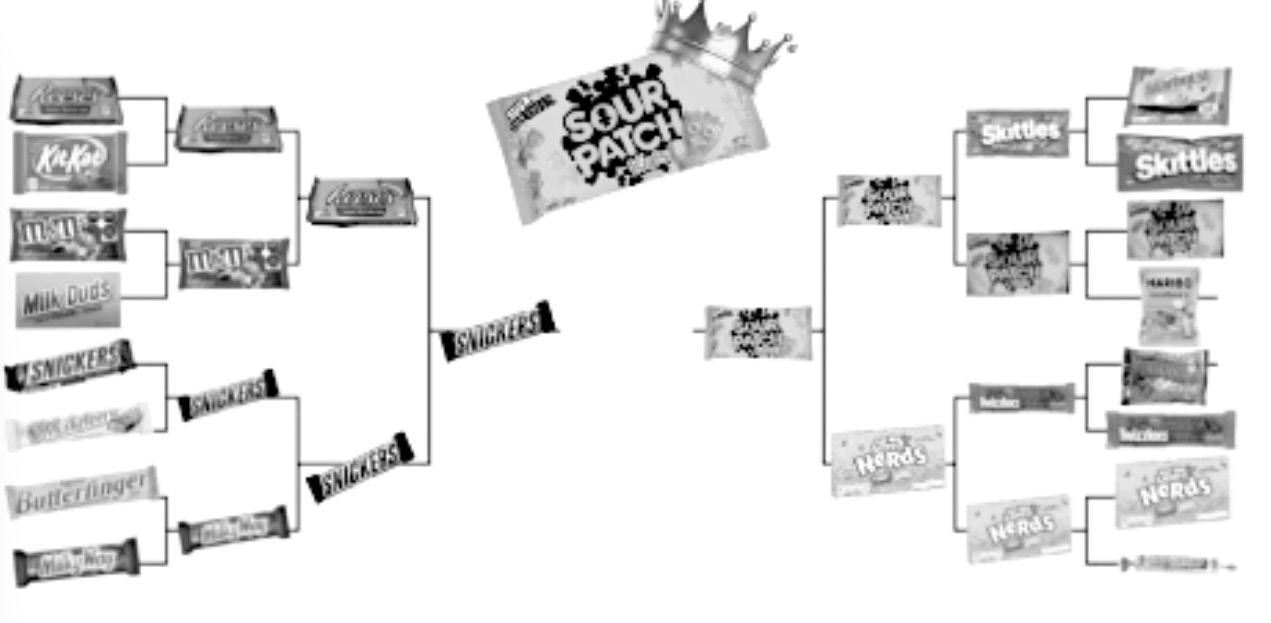
thesamohinews@gmail.com
Ashley Tan Staff Writer
As a new school year at Samo unfolds, students have noticed new policies and a stricter enforcement of pre-existing rules. Whether it’s at football games, pep rallies or other school events, the school security and policies seems to have tightened for the ’25-’26 school year.
Pep rallies, run by the Associated Student Body (ASB), happen twice per semester. Key aspects of these pep rallies are the student games, which are played between representatives from each graduating class. Staff members such as Coach Ramsey Lambert see these activities as a way to foster school spirit.
“When students see their peers on stage as an athlete or performer, students will cheer for their peers in support,” Lambert said. “They also build a sense of community when you bring everyone together and show them they are a part of something bigger.”
Starting this year, ASB took initiative to better control student booing at pep rallies, breaking the rather unconventional tradition for Samo students. With the intention of creating a positive and welcoming environment for the incoming freshmen, ASB has repeatedly stated that students will lose privileges if booing and taunting take place–even going so far as to revoke popsicle prizes and remove students from the rally. Samo student and ASB member Annabelle Thorpe (’26) views the shift as a positive development due to the diminishing nature of booing at the rallies.
“I think pep rallies are for everyone, so it makes sense that seniors aren’t supposed to boo at the underclassmen. They’re supposed to uplift everybody as a community,” Thorpe said. “I think the students in the senior class aren’t really seeing it as that negative, because they got booed when they were freshmen. But incoming freshmen, they don’t really know what’s going on, so now they’re going to take it personally.”
However, this new policy has also received negative feedback and pushback from students such as Diego Guerra (’26), with many saying that the policy is unnecessary and kills the fun from the rallies. Driven by class rivalries, most students see the booing as a way to have fun and show class spirit.
“I think [booing] shows class spirit. I mean obviously booing inherently is negative, but, you know, the school participated when I was a freshman,” Guerra said. “They played wheels on the bus for us and treated us like babies and we got booed. But there wasn’t any malice behind it.”
Additionally, school security measures have intensified. While morning student ID checks have been routine, the orderliness has noticeably increased when compared to previous years. Security guards who carry out this procedure, such as Chris Smith, agree that the ID checks are necessary to maintain a safe campus and student account ability.
“With ID checks, we want to make sure that all students have IDs so we know that you belong on campus, [and] to avoid problems where students from other schools might try to come on campus,” Smith said.
These policies are not just limited to school hours. At after school events like the annual Homecoming dance and recur ring football games, entry requirements and various security measures have been added. Students face the possibility of being denied entry if they come with a backpack or bag and have to empty their water bottle if they bring one.

“One thing I do know [that] we’ve started doing was the clear bag policy [at football games]. I believe they’re saying either clear bags or your bags will be checked,” Smith said. “Small bags will be checked upon entry for safety reasons.”
To many students, the clear bag policy is unnecessary
and makes the process of entering a football game overly pletely necessary, because we’ve never had issues with students bringing in anything they shouldn’t,” Thorpe said. “It would make sense if our school had a clear bag policy and therefore our football games did, but as a public school, that doesn’t make
The policy enforcement around Samo of existing rules including changes made to pep rallies and additional security measures draws attention to community safety and security around campus. The effect of these policies have been noted by students and their effects will be continuously relevant to Samo at large.






Yaretzi Preza Staff Writer
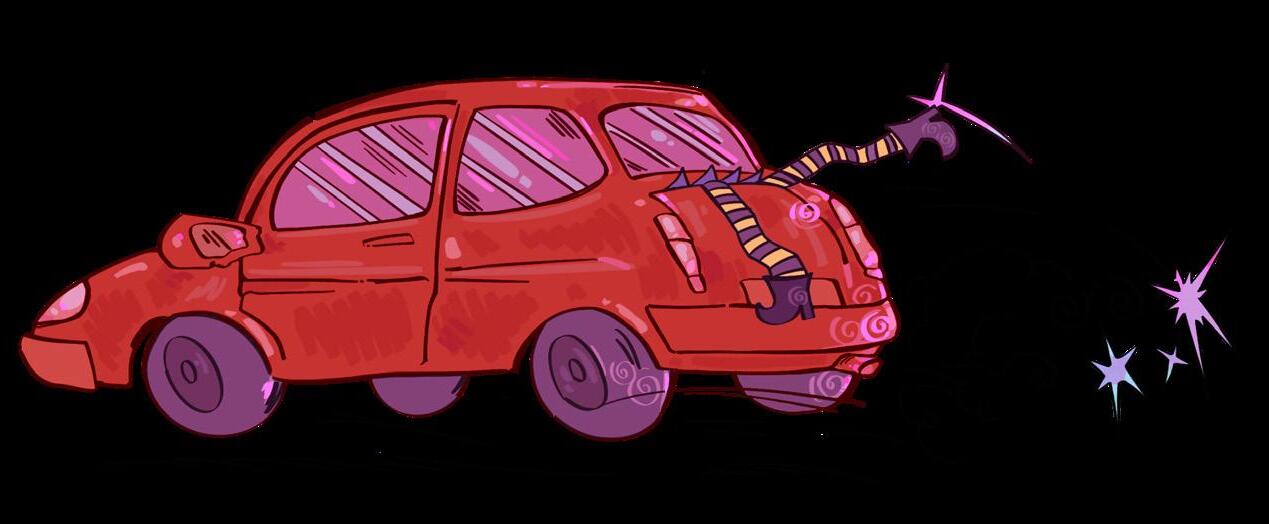
*This is a satire piece, quotes and content are not factual, no cars were harmed*
As of today, Oct. 31, a donated red Chevrolet Corvette C1 in the Samo autoshop has been reported missing. A search warrant has been placed to gain access throughout campus to identify the missing vehicle.
Under the innovation building remains a hidden part of Samo. Tere lies an elite autoshop only the up perclassmen have access to. In the autoshop, the red Chevrolet has recently been repaired and tucked away under the security of the trusted Samo staf
Consulting with police ofcers about this violation, it has been confrmed that autotech student Loa Garcia Lopez (’26) was last seen with the car. Lopez claimed to be checking the engine since it had prob lems with the valve cover, more specifcally, the oil dipstick, just before it was under the supervision of the security guards. Currently, Lopez is refusing to make any public statement regarding the activity of the missing Corvette.
Just two foors above the auto shop, Chemistry teacher Jenny Forster spoke to the police as she claimed she saw two young students in the shop. Forster saw the students on her walk to the daycare center to see her child. Walking across campus from the innovation to the language building, Forster described an indepth witness statement about her fndings.
“It happened so fast,” Forster said. “I panicked and ran to the daycare to check on my kid.”
Shortly afer she saw the students tampering in the auto shop, she was suddenly alarmed at the thought of her child in danger. She was quickly relieved when she saw him on his midday walk around campus afer receiving notice of his short absence during fourth period, according to one of the daycare’s supervisors. Double-checking the safety of the child, no one had a clue where he disappeared of to.


As a verifcation from advisors reporting about so-called suspicious students from Forster, it has been confrmed that those students are in her third period chemistry class. She has now been questioned by the police for her role in misleading the investigation.
While the news broke out from a security ofcer, D, at around 3 p.m., forensics found a size 10 oil footprint matching the similar heel pattern of D’s shoes. When questioned about the reason D was in the autoshop, as he was scheduled to watch Michigan gate, he slowly began acting jittery.
“I accidentally lef my gloves in the autoshop when giving out a call slip, so I had to go back and retrieve them,” D said. “I must’ve stepped in some oil on my way out.”
As the underground auto shop has become more recognized, students across campus have been protesting against contributing to the search for the missing vehicle. A particularly vocal witness, Daniel Diaz-Bentancor (’26), says that he had overheard a heated argument with security ofcer D and autotech student Marko Zelennovic (’26). In the exchanged conversation, Diaz-Bentancor suggests that there was an attempted fraud scheme with the Corvette, potentially leading up to its disappearance.
“To be honest, I had no idea what they were talking about,” Diaz-Bentancor said. “Did you guys know about autoshop? I didn’t even know Samo had one.”
When bringing Zelennovic into the interrogation room, investigators grilled him with numerous questions regarding his new credit activity with a transfer of nearly six fgures added to his balance.
“Listen, I do some side-hustling to make my money and there’s no crime involved,” Zelennovic said. “But
they began rufing through his backpack. To their surprise, a pair of car keys were found in a wrapped envelope with a red key chain—one only the Corvette had.
With all the information present, the police department is continuing to conduct this ongoing investigation. But with the compacted evidence gathered, each suspect has an equal chance of being the culprit.
It’s uncertain if the truth ever comes out. Who do you think is responsible for this heinous crime at Samo?
Stay tuned on Te Samohi’s Instagram (@thesamohinews) to fnd out the culprit…




















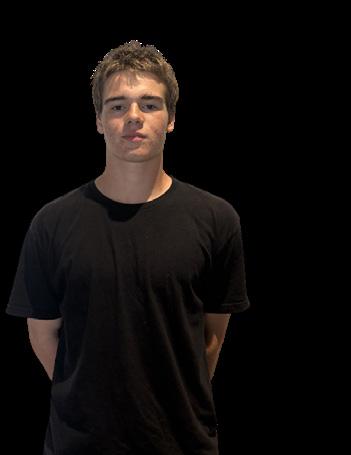








-
culprit. Samo?
form of self assembling one’s costume was a sign of love for established culture. People also used festive attire as an outlet for creativity and repurposed old clothes with new pieces as a way to bring a character to life. Instead of buying one out set from a specifc store or online, people began to shop around for singular pieces and give them a new purpose as part of a larger vision. Te use of social me dia styles and imaginative content led to a widespread exchange of ideas which blended into the resurgence of this costuming. Inspiration spread to people constructing grander disguises and pushing the boundaries of their experimentation. Samo student Veronika Brandt (’26) talks about how this culture infuenced her own DIY costume this year.

subject that is not commonly explored. Tis concept evokes a certain squeamishness and discomfort in the audience, pushing them to cover their eyes and look away; her character is not seen as beautiful enough for her sexuality to be palatable and therefore her behavior is viewed as twisted and ‘not age appropriate’.





“Ive seen a lot of people, especially on Etsy and stuf, create their own wings and their own stuf so I feel like I have inspo online,” Brandt said. “Its a cool community and it’s also just inspiring seeing people that go above and beyond with their costumes and make really intense stuf.”
With the fashion landscape being tied to Halloween costuming, there has been a regression of these self-molded costumes, with the easier alternative of fast fashion and online shopping taking over. Despite this, the remnants of DIY attire thrive through the modern day, with an overall cultural shif to vintage clothing evoking a desire for older times. Te rise of thrif-culture and sites like Depop prove the yearning of society to regain nostalgia through vintage pieces and trend revivals that call back to 2010s Indie Sleaze and 2000s Y2k periods. With this urge to return to a time less involved with the overly commercial, it makes sense that many have returned to the do-it-yourself form of celebration.
e values behind the DIY attire paints an interesting story in tandem with the changing times throughout history. Whether it be out of a scarcity in wartime or bred out of inspiration from new technology, the act of designing a Halloween look is important for self-expression and adds a touch more excitement to the holiday season. Lilian Minzenberg (’28) sums up her view on costume traditions and their role in Halloween.
“Whenever I do Halloween costumes, you gotta go all out. If you’re committed you’re committed. I like to be creative with what I wear and how I express myself so I just wanted to go all out with that. I feel like that’s part of Halloween, there’s no fun in buying a whole costume,” Minzenberg said.
ons in order to evoke fear. Film in general portrays older men with far more grace than older women; the ‘silver fox’ archetype displays how wrinkles and gray hair ofen make men more attractive, an inverted interpretation than that of women. It is hard to tell whether this trope is efective in criticizing our beauty standard since it plays so heavily into it. Tese flms would not be as terrifying or grotesque if we did not have preestablished biases against female bodies; they in fact rely on our disgust in order to pull our focus, therefore hypocritically feeding into the system they are attempting to condemn.

e contrast between the young heroes and old villains creates a clear divide between good and evil - evilness which is unfortunatened by the inevitable - aging. Te idea of becoming old has seemingly taken over this generation. Anti wrinkle straws, preventative botox and elaborate skincare routines have all been shoved into the mainstream, preying on young women and forcing them to fear the unavoidable. Tese ideas that society has been pushing lms like this to hit so close to home for women; displaying a hunched back, decrepit woman as a murderous maniac instills more negative connotations surrounding the idea of aging, forcing the audience to think about what they might become. Tough t into the ‘good’ now, the idea that they will one day be a part of the ‘evil’ plagues their viewing experience. English teacher Elizabeth Waters refects on this loss of innocence.
“I think one reason that beauty standards are so important, particularly for women, is because women’s sexuality is also really emphasized in our society,” Waters said. “And so I think there’s kind of a view of, if you lose that aspect of yourself, you are losing the
Although these movies claim to be criticizing the trivial fears that overwhelm modern society, they rely heavily on perpetrating stereotypes and committing to negative cliches in order to turn their movies into horror movies. Te truth is, the only time we see the wrinkly, sagging features of these women in the media is when they are portraying these ‘creatures’, appealing to the perverse disgust we feel surrounding women’s aging bodies. Society has brainwashed us into viewing these women as horrifying, making this trope proftable for distributors and entertaining for audiences. Waters highlights the potential consequences following the continued depiction of these caricatures.







Similar to this, creepy nude old people have been plastered throughout modern media as a form of awkwardly-erotic shock-horror. Like in “Te Shining”, “Midsommar” and a plethora of other flms the naked bodies of the elderly - specifcally elderly women - have been used as props to brew uncomfortability and perplexity among the audience. Exposing intimate parts of their anatomy splayed with wrinkles, sunspots and stretched out skin forces the audience to confront their preconceived notions of what kind of nudity is acceptable on screen. Tis contrasts with how older men are conveyed in the horror genre. Despite portraying antagonists far more than women, these male villains don’t play into sexual or provocative scenes, instead they take on more common traits like physical disfgurements, scary masks or large gaudy weap-
“When we engage in stories that use the same trope over and over again, our brains start to believe things about that group because we see the same portrayal over and over again,” Water said. “Subconsciously, we start to say, ‘Oh yeah! these things are linked.’”
Te question lies in whether this archetype can be done in a tasteful way that accurately criticizes our gripes surrounding the aging women. Scary old women in the media are not going away anytime soon but the next time their thin wrinkled skin plasters your screen, ask yourself why you fnd them so terrifying in the frst place.








Otem Free Staff Writer
Fried chicken has become something of a craze in Los Angeles (LA) over the past few years, with multiple restaurants popping up rapidly and big chains sprinkling locations around the city. While cities in the Southeastern United States are most common ly recognized as the centers for fried chicken, such as Nashville, Tennessee, LA has made a market of its own on the West Coast. But behind all of this, there’s a rich history behind how fried chicken got to this point in LA, a city with deep roots in Southern cuisine.
The tradition of frying chicken in oil dates back to the 18th century, but it reached what would be the modern-day United States when Scottish immi grants brought the practice to the American South, where it was embraced and perfected by the enslaved African community. After the Emancipation Proclamation was issued in 1863, fried chicken shifted to a food for entre preneurship. Many black women made money from selling fried chicken and became the primary sellers in the South.
The introduction of fried chicken into LA began with the Second Great Migration (1940-’70), a mass exodus of African Americans who left the Deep South in search of better opportunities within urban areas in the North and West of the United States. Many African Americans saw opportunity in the growing manufacturing industry on the West Coast, specifically in California and decided to settle. This mass migra tion brought the transfer of Southern food traditions, according to an article by Eater LA regarding Southern food influence on LA. Additionally, this is when the first traditional black soul food restaurants began to pop up around LA. Some of these restaurants remain open to this day, including Roscoe’s House of Chicken & Waffles and Dulan’s.

Fried chicken has also made an impact here at Samo, with some students, such as Kaden Friedman (’28), expressing their love for the food.
“I just love how the flavor burns your mouth a little bit, but it’s in a good way,” Friedman said. “I saw it on Uber Eats one day, and it looked good. I also saw people on social media eating it, so it motivated me to get some.”
After years of predominantly traditional fried chicken in LA, a new version began to emerge in the Koreatown neighborhood. Brought over to LA by immigrants from Korea, Korean fried chicken didn’t blow up immediately but remained relatively un-hyped for some time, leading up to the 1992 LA Riots, which caused a major reconstruction in K-Town nightlife. However, the major factor that helped propel Korean fried chicken into the spotlight was the opening of prominent Korean fried chicken brands, such as Kyochon (2004), Bonchon (2006) and BBQ Chicken (2008). From there, social media and Gen Z helped spread its popularity, cementing Korean fried chicken as a major branch of the fried chicken industry in Los Angeles.
In 2015, a Nashville chef named Johnny Ray Zone opened a food truck that specialized in Nashville Hot Chicken called Howlin’ Rays in the LA area. This was followed by massive lines and incredible hype behind it, so much that it caused the opening of a location in Chinatown, LA, where wait times are notoriously long during peak hours. This reaction also caused the pop-ups and expansion of other Nashville fried chicken restaurants in LA, which grew into big companies themselves, like Dave’s Hot Chicken (2017).
From the South to its modern-day reinventions in Los Angeles, fried chicken is one of the foods that has continuously adapted while preserving its original traditions. What began as a survival food for African Americans has turned into a comfort food staple that bridges different cultures and communities here in Los Angeles. From Korean Fried, to Traditional Soul, to Nashville Hot, each interpretation of this food will continue to shape LA’s culinary landscape.
Art by Florence Fraiser-Macduff
thesamohinews@gmail.com
Kira Willinger Staff Writer
As the Halloween season comes to an end and trick or treating and pumpkin carving become activities of the past, students reminisce on times when their biggest worries were how much candy they were going to get compared to their siblings.


“My favorite memory was when in elementary school, we would have a costume parade and the younger kids would walk around in their Halloween costumes and the older kids could watch. [I loved] that I got to see everyone else’s costumes.”
- Lena Tsay (’28)
“When I was younger, I would go to my church’s autumn festival, which is their version of Halloween. It was mostly just these fall themed games, but my favorite one was where we would go through a bunch of coffee beans and we’d have to look for these little pumpkin erasers, it was really competitive.”
- Erin Lau (’28)

“My nostalgic Halloween memory is picking out Halloween costumes with my family and just going to the store and picking stuff out and talking. And one year for Halloween in elementary school, I was the Cookie Monster.”
- Santiago Aquino (’27)

“Every year I join a Halloween surf competition. Basically it’s not really competitive, but it’s more who has the best costume and who’s the most stoked and having the most fun. It’s really cool because sometimes we give out a surfboard and other times it’s more Halloween-based prizes.”
- Alex Briller (’29)
Audrey Stephansen Staff Writer
At the Homecoming Game on Oct. 10, the final winners of the Homecoming court were revealed. Homecoming royalty has been a tradition at Samo for many years and it is custom for the final contestants to be presented at the rally the day before the dance. These contestants had to nominate themselves to become Homecoming Royalty and the students at Samo voted to narrow down the runnings to get the five final pairings. The remaining couples were Edie Kaufmann (’26) and Kyle Matsui (’26), Sadie Gryczman (’26) and Archie Windsor (’26), Chloe Sanders (’26) and Manny Lopez (’26), Gelila Mihret (’26) and Payton Seals-Mcclellan (’26) and finally Leona Jones (’26) and Luke Shimahara (’26). The couple named homecoming royalty was Sanders and Shimahara. Winning the title of Homecoming King and Queen is a significant achievement that requires a great deal of hard work and self-confidence from the candidates.
“One thing I did to promote myself was to use word of mouth. I was telling my teammates to tell their friends to vote for me. I was also in a couple of my teachers’ classes and my friends’ classes, writing my name on the board and encouraging people to vote for me,” Sanders said.
“Personally, I used social media as a big tool to help campaign and promote myself. I felt really surprised when they announced me as the winner, but I was very happy with the results,” Shimahara said.
After all the Homecoming Royalty candidates put in lots of time and dedication to winning the title, the victors taking home the crown signified the end of a successful homecoming season.
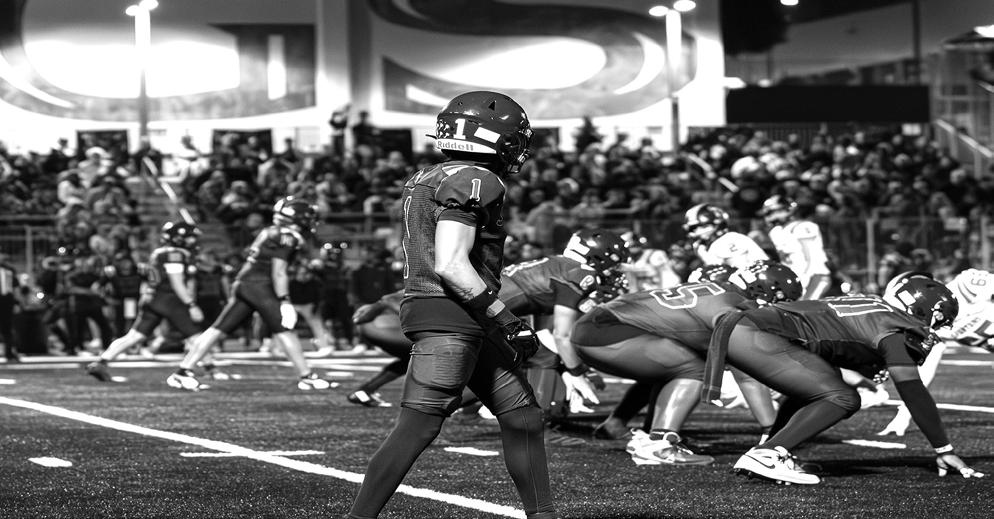

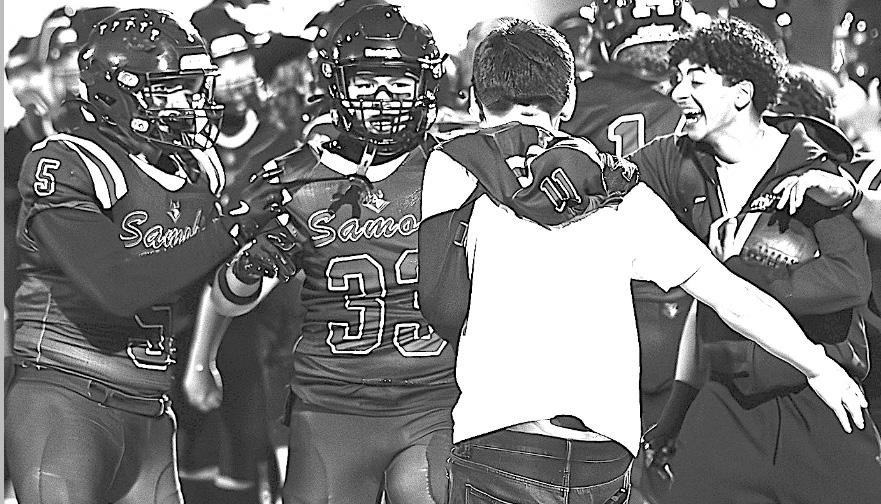


Paul Thomas Anderson’s long-awaited directorial return, “One Battle After Another,” was released on Sept. 26. This film starts off sprinting and somehow manages to keep up that pace for a lengthy two hours and 50 minutes.
Jumping into action with a cold open, we are introduced to a group of revolutionaries named the French 75 and immediately thrust into their ambush of an immigrant detention center on the U.S.-Mexico border, under the defense of an austere Colonel Lockjaw (Sean Penn). Led by Perfidia Beverly Hills (Teyana Taylor) and armed by Pat Calhoun a.k.a. Rocketman (Leonardo DiCaprio), the group launches a loud and almost gaudy attack, with the group members revealing their faces, announcing their names, shooting arrogant celebratory shots and announcing to the world that their “saviors” had arrived. This was the first in a series of attacks that make up the film’s prologue, all of which pursue an anarchical tone, highlighting a radical revolution of sex, violence and most of all American liberty.
Romance blossoms between Pat and Perfidia, leading to the birth of their daughter, Charlene, an event that coincides with the downfall of the French 75. The end of this operation forces the two revolutionaries to be pulled in opposite directions; after a 16-year timeskip, Pat and Charlene are reintroduced under the new identities of Bob and Willa, with a newly motivated Col. Lockjaw hunting them down.
Willa (Chase Infiniti), now a 16-year-old high schooler, is an independent, self-sufficient, star student who perfectly contradicts her now messy, paranoid, drug-addicted and alcoholic father. These separate personalities pull the audience into two different perspectives as the story unfolds. Following a strungout Bob as he struggles to revert to his past revolutionary ways for his daughter’s sake is the perfect mix of comedy and anxiety-inducing drama. The characters create a balance that perfectly plays off each other, despite them being separated for the majority of the film.
These moments are only amplified by the enthralling score that - like some shots - is leisurely drawn out in an anxiety-inducing manner.
Anderson writes in a manner that balances both drama and humor, crafting a script that presents complex and dark topics in a way that is palatable and easy to consume. Jokes snuck into prolonged, plot-heavy scenes help keep the audience engaged and entertained throughout the lengthy run-time. They wonderfully break up expository dialogue to make it feel less overwhelming while successfully developing the story.
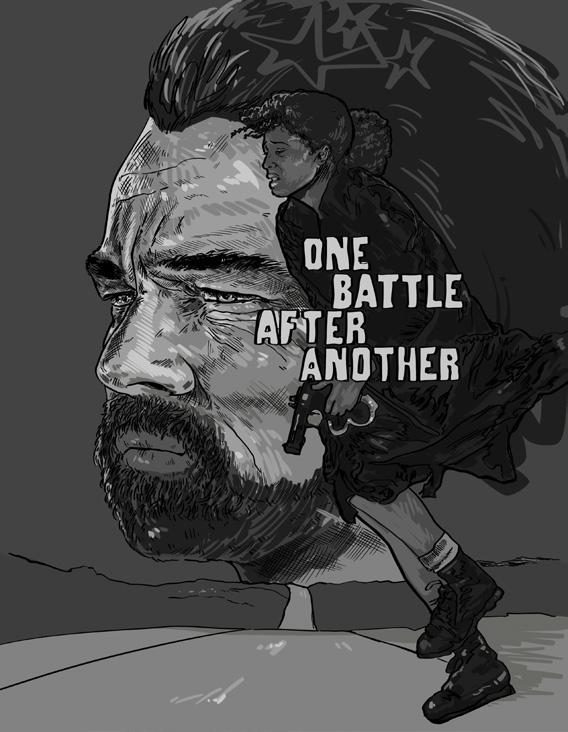
“One Battle After Another” is the type of movie that grips you in during the first second and refuses to let you go. Anderson’s use of close-up shots and painfully slow zooms spotlight actors’ performances, almost like a theater production. These prolonged scenes stretch into extended silence, creating a suspenseful and tense atmosphere that leaves the audience on the edge of their seats.
Jefferson Tinus Staff Writer
One of the most remarkable aspects of media is that people have the ability to interpret it in any way they deem appropriate. This is media literacy, a term defined by the ability to critically analyze stories presented in media and determine their credibility and accuracy. For some forms of art, the effects of one’s interpretation can cause real-world events that stretch far beyond the piece itself. Looking at classic literature, books like “To Kill a Mockingbird” have influenced many subsequent generations to challenge injustices in society. One author who has taken inspiration from Harper Lee’s writing is lawyer Bryan Stevenson, whose own book, “Just Mercy” was summer reading for many Samo Juniors this past year. Stevenson writes about how the journey of Mockingbird’s main character, Atticus Finch, inspired him to pursue a career in law to help the wrongly accused. Despite the novel’s importance to him, Stevenson uses media literacy to acknowledge how the book romanticised aspects of racial justice and perpetuated a false sense of progress in how it was understood. It is important to see how he was able to question a work that he himself noted as inspiration and create a larger conversation around its overall effects.
Despite the positive influences of this novel, districts throughout America have banned “To Kill a Mockingbird” for its discussions of racism, making it one of the most frequently banned books in the country. Many other novels that challenge soci etal norms are met with a similar fate of banning. The discussion of women’s rights was silenced in the banning of “The Handmaid’s Tale” and, ironically, “Fahrenheit 451”’s own criticisms of censorship led it to meet a similar fate. Despite the important discussions these books have brought about, local government response in many areas focused on stifling these voices instead of focusing on why they are considered contro versial. Hushing controversy instead of raising intellectual discussions drives society away from necessary critical thinking and in turn reduces media literacy. For instance, access to novels like “To Kill a Mockingbird” set Stevenson on his path of legal studies, yet his deeper media literacy is what helped him see the more complex issues at play and moved him to the field of social justice.
The movie follows the point of view of both the military and the revolutionaries, creating a strict contrast between authority and defiance. The constant shot-reverse-shot between the hunter and the hunted puts the audience into the position of both parties. Still shots positioned peering through windows that cut to hand-held cameras tracking the nervous movements of the subject push two distinct perspectives onto the viewer. Being propelled into this role of “surveyer,” makes the audience feel as though they’re a part of the film, but also as if they know something they aren’t supposed to.
Emphasizing this division, Anderson juxtaposes government violence with civilian violence. The military’s brutality was consistently targeted at innocent citizens, highlighting their skewed perception of what a threat might be. They saw opposition as a danger and therefore sought to crush it.
On the other hand, actions committed by the revolutionaries fall under an umbrella of ambiguity; the work they do is destructive and disruptive, but it is justified by their intentions to better the world and criticize the corrupt government. The film also works to radicalize this violence, expressing Colonel Lockjaw’s neo-nazi-esque motivations and his distaste for any and all minorities.
Amidst the recent ICE raids and nationwide protests, this movie is nothing short of extremely timely and poignant. It leaves the viewer wondering, to what extent can the government perpetrate violence before it is considered an abuse of power? During an initial viewing, it appears that Anderson somehow created a distant and dystopian environment, overwhelmed with chaos and injustice lingering under the surface. But once you take a step back to observe the bigger picture, it becomes clear that this seemingly faraway world perfectly mimics our own.
thesamohinews@gmail.com
because of its subtlety. While social media in moderation may not be directly harmful, its role in replacing genuine news sources is shaping the world view of its users dangerously. As a result of each person’s individualized feeds on apps like Instagram and TikTok, the distribution of content is not meant to show each person an unbiased view of the world, such is the job of a news source with integrity. Instead, these algorithms give users a personalized page of media which the users have no direct control over. With the goal of the algorithm being to keep its user engaged as long as possible, these ‘For You’ pages are made to show their audience agreeable media, effectively censoring them from seeing other perspectives. Researcher Nora McDonald writes about this phenomenon for ‘The Conversation’, a publication based on the protection of knowledge.
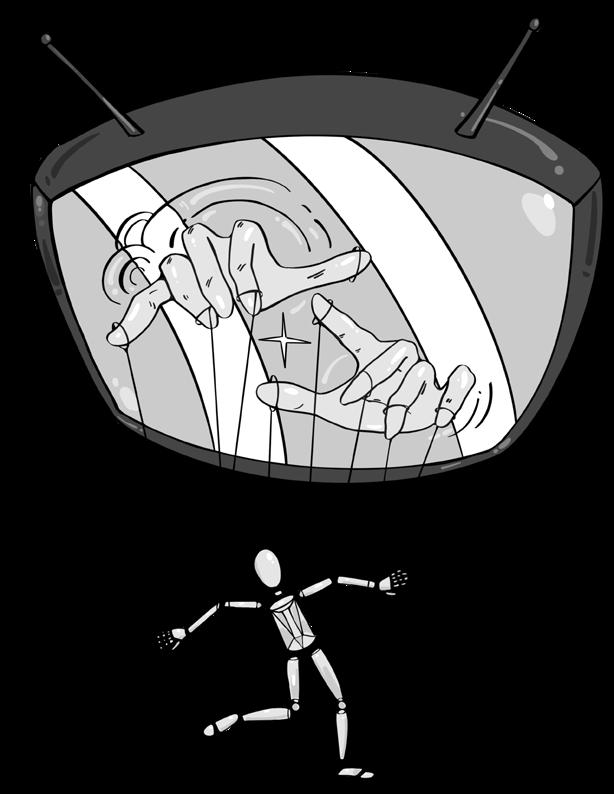
In addition to direct government censorship, the current state of media literacy is being reduced through representation of a singular perspective. The issue of banning classic literature in an attempt to portray one narrative is mirrored in the modern day through social media which limits perspectives and is based on the spread of biased information.
The design of social media has led to an algorithmic type of censorship, one that goes unnoticed

“Curated content is not just ‘for you’ but also ‘about you’–a mirror reflecting important signals about the person you are,” McDonald writes. “Teens we spoke with say they prefer a social media completely customized for them, depicting what they agree with, what they want to see and, thus, who they are.”
Actively denying its audience an opportunity to see opposing perspectives makes social media an echo chamber of one’s preexisting notions. Rather than providing new perspectives, these algorithms reflect what a user already believes for its own benefit. Based on McDonald’s own observations on what teens prefer, this sentiment seems to be something that users agree with in regards to their content feeds. Circling back to the topic of media literacy, social media poses a large threat to how people intake media. Mixing so many uncredited and biased sources into people’s main intake of news makes determining validity of information near impossible. Without the ability to understand how credible or accurate this information is, media literacy is being actively attacked by social media on a daily basis.
Over time, this epidemic in media illiteracy will continue to spiral and devalue true journalism. Public opinion will be drawn to biased media over impactful and accurate news, lacking any insightful division that fosters growth. Opposing viewpoints will continue to echo their own ideals while attacking the opinions of others, diminishing the ability to have a civilized debate. Online verbal attacks will push surface level controversies forward and make it harder to create effective commentary. This is the world we will live in with the death of perspective, a world that gets closer every day as a result of censorship and social media replacing journalism.
Down: 1. ____ Potter 2. Popular director
Arrested Development Genre 6. Swedish 1970s band
8. Home of Bollywood 10.____ Ferreira (2010s pop-star)
13. ____ & Flick!
14. Area in between words on a script
15. Song commonly employed to teach young children the English Alphabet.
With school approaching the halfway mark into the semester, we asked some Samo students what their go-to study music is when they need to focus on schoolwork. Do people prefer soft, low-beat, classical music to sooth them through their work, or do they need music to be more hype for them to focus? Here is what people around campus had to say about this:

“There is a boiler room DJ set on YouTube by Horse Girl, it is her second boiler room set from CDMX in Mexico City. It is about an hour long, and that is what I listen to almost daily.”
- Colin Hendler(’27)
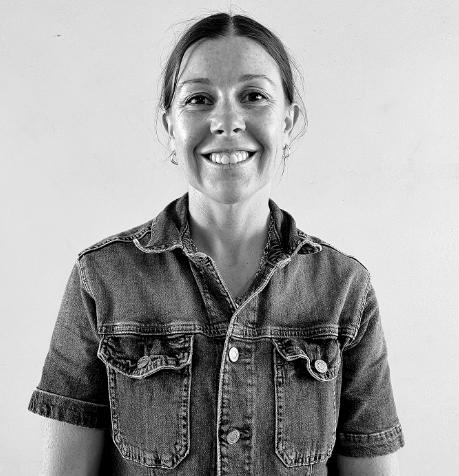
“When I want some background noise, I usually prefer podcasts, and my go-to is I religiously listen to the daily by the New York Times every day, also their new podcast. I love Airchair Expert and Kylie Kelcy’s podcast as well as anything on parenting, or fitness, or books.”
-Jessica
Gutierrez
The Día de los Muertos art exhibition opened on Oct. 23 from 4-7 p.m. at the Roberts Art Gallery, showcasing Samo and JAMS art students’ pieces. This yearly exhibition serves as a communal space where students in all of the different art classes on campus come together and are able to honor the cultural significance of Día de los Muertos.
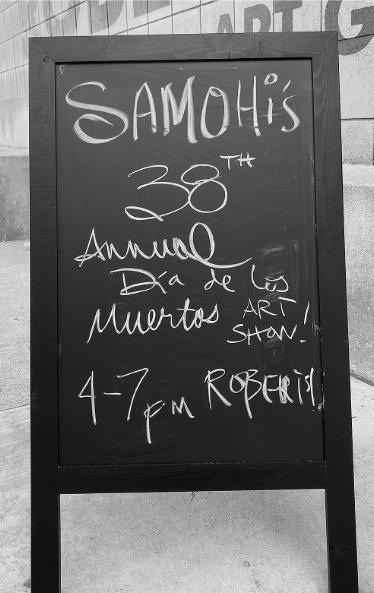
Día de los Muertos is originally a Mexican holiday, but the happiness and shared connection are feelings that are felt between all different cultures when celebrating. A common misconception is that Día de los Muertos is a sad and mournful holiday. While it is a holiday to remember deceased loved ones, the celebration of their life is the main focus. People create ofrendas (altars) decorated with flowers, candles, food, and the photos of their departed family and friends. Samo’s Roberts Art Gallery commemorated Día de los Muertos with presenting students’ vibrant creations, honoring the spirit of light and festivity that characterizes the holiday.
day to practice art, as it can be relaxing and a way to get ideas out. Gonzalez showcased a vibrant calavera (skull), which she executed with the inspiration of her Puerto Rican culture.
“My inspiration for [the ceramic calavera] was my ethnicity and cultural background. I am half Puerto Rican, so I took inspiration from the Puerto Rican flag and their national symbols,” Gonzalez said. “[This gallery] makes me feel very excited because I also get to see everyone else’s work. I love admiring everyone else’s pieces and I hope that some people are inspired and/or like mine.”
At the exhibit, the drawings and paintings were hung on all sides of the room. There was a welcoming and radiant atmosphere to the gallery, reflecting the individual touch each student artist left on their works.

The clay sculptures were neatly arranged by the students’ period, showcasing the different thought processes and creative ideas they decided to portray. Each of the students took the traditional skull head shape and turned it into a unique artistic statement. There were two altars, complete with clay food, marigolds, candles and photos brought by different families, giving the altars a personal and heartfelt element.

“When I seriously want to lock in, I spam lo-fi music, or if I am feeling in a good mood, then I listen to more upbeat music to get me motivated.”
-Rashida Ismael(’28)
Ceramics I student Ava Gonzalez (‘28) has always loved working with different media to create art. Gonzalez has been involved with art for many years, specifically watercolor painting. When she saw that Samo offered a ceramics class, she was thrilled and jumped at the chance to join. As an advocate of artistic expression, she believes that all students should find time in their


Adding to the diverse environment, Latin American flags were displayed, recognizing the varied cultural backgrounds that celebrate Día de los Muertos. The gallery was full of wandering students and families from opening until closing time.
thesamohinews@gmail.com
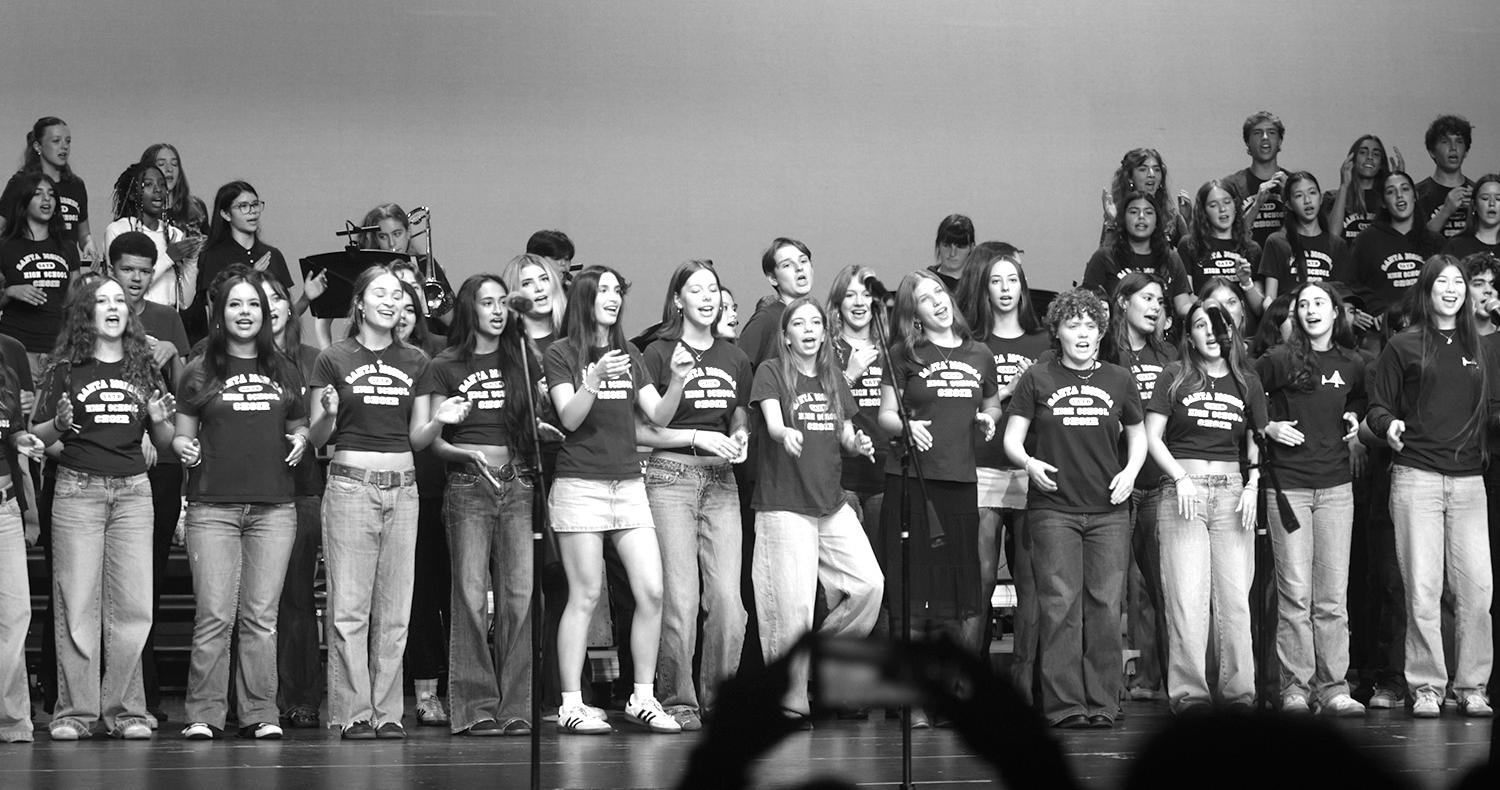
Middle School (JAMS) in Santa Monica. Choir students performed a variety of pop, alternative, and country music from multiple eras. The event is the choir’s biggest fundraiser of the year and is an important source of income for the program.
However, before any of the onstage performances, a significant amount of effort goes into planning the event, with choir students at the forefront. Chorale choir student Nyah Latif (’27) explained the process.
“The students of the Samo choir program usually prep throughout every class period. We start the day with sight-reading practice, followed by vocal warm-ups, and then we jump into our songs for the performance.” Latif said. “We have auditions for soloists, and if you are chosen, you practice with your individual choir and with all of the choirs combined. We practice both during school hours and after, using JAMS as a practice and performance space for our productions.”
As the choir’s main fundraising event, there was a lot of emphasis placed on fundraising throughout the night. During the show, there were also breaks in between songs to advertise fundraising, mainly the online auction. In the main greeting area outside the auditorium, where the show was performed, there was a concession stand, and a raffle was held for attendees to participate in. Prizes included an E-Bike, AirPods, and Angel City FC tickets, all of which were donated to the program, and there was a segment near the end of the show where the winners of the raffle prizes were announced. On top of this, there was also a VIP reception area, which allowed attendees with a
VIP ticket to enjoy food and a mocktail as well as reserved seating inside the auditorium. Choir director Jeffe Huls has run the Sweet Serenade Event since its beginnings.
“Since its inception, it has become our only fundraiser; we do not ask our students to sell anything else,” Huls said. “We put all our energy into this one event. That is why its success is so important.”
The performance itself lasted roughly two hours with a 15-minute intermission in the middle. Different choir groups performed a variety of genres, featuring songs such as “Pompeii” by Bastille, “Toxic” by Britney Spears, “Somebody to Love” by Queen, and “Jolene” by Dolly Parton. Students also performed the popular song “Golden” from the movie K-POP Demon Hunters. Accompanying the choir was a serenade band, which consisted of students and the choir directors playing various instruments.
Chorale choir member Sawyer Wells (’28) shared his perspective on the performance. “It’s more fun and less super serious. If it were to be a winter concert or our spring concert, those are serious ones,” Wells said. “This one’s fun and punk-rock, compared to the really opera-type stuff, it really shows how we’re still being taught amazing music, and how we could unite as a team and sing and be well-organized. And it shows that our district is doing a good job at teaching us that. It’s a very connecting experience.”
The choir still has other performances to come, including the Winter Concert, Motus Perpetus, and the Spring Concert, which are more traditional choir concerts.
Jack Goldberg Staff Writer
The University of California Los Angeles’ (UCLA) football program has been rife with struggles over the past couple seasons. Most recently, UCLA finished 3-6 within the Big Ten Conference after a transition from the Pac-12 Conference, which was first announced in 2022. A lackluster 0-3 start to the program’s second season in the Big Ten culminated in the firing of UCLA head coach Deshaun Foster on Sept. 14. Foster’s departure from UCLA marked an end to a struggle filled era in Bruins’ history, holding a record of 5-10 through his tenure. Tim Skipper, the special assistant to the head coach, was named interim head coach for the remainder of the season.
Firing a problematic or bad coach may have sounded like an easy answer to all of UCLA’s problems, but a new coaching staff taking over in the middle of a season comes with a lot of its own issues. A new ideology and playbook can massively impact a team’s synergy, only being expounded with such short notice. This was shown during week four when the Bruins lost 24-38 to Northwestern, dropping them to 0-4 and making them the worst ranked team in the Big Ten. With their troubled start season, most fans were quick to write off the season. Another year of growing pains as they regeared with a more stable coaching situation for next year.
Jack Waterstone (’26), a student at Samo and hardcore fan of the Bruins, was asked about the importance a coach’s personality has to a team’s success.
“I think it’s super important, especially just bringing the group together, whether it’s just high school or even college or pro. I think from a personality standpoint, the coach is the guy that brings the team together. I mean, I saw a video of Jerry Neuheisel after the game in the locker room. He had the whole locker room fired up, they were throwing water bottles, and it just looked like they were having fun. So, yeah, I think coaching personality is super important,” Waterstone said.
Coming into week five, expectations were low for UCLA as they were slated to face Pennsylvania State University (Penn State), who were now playing with a chip on their shoulder. Penn State was coming off a brutal loss against University of Oregon, reigniting speculation and dropping them four spots by the Associated Press. UCLA was 24.5 point underdogs for their Oct. 4 game and the questions entering the minds of many college football fans was how big of a bounce back James Franklin and Penn State would have, rather than if it would even be close.
Defying all odds, UCLA stunned the entire world of college football. Penn State was kicked out of the top 25 for the first time in three years as UCLA beat one of the best teams in the nation in a 42-37 shootout win.
Following the massive upset over Penn State, Jerry Neuheisel in particular has gained a lot of traction online for the incredible turn around his offense. Turning an almost anemic offense during the first four weeks into a well oiled machine, scoring a combined 80 points against Penn State and Michigan State.
These wins don’t happen out of sheer coincidence or luck, coaching plays a crucial role in a team’s success. Being able to
make players buy into a culture can make all the difference between winning and losing. Belief in the playcalling and the motivation that can be gained through a good coach can be the needle mover in many of these games.
The recent run UCLA has been on has been a surprise to many, including fans like Waterstone.
“I definitely think there has been, you know, not nobody really knows Jerry’s offense. Nobody knows, you know, he could be pulling out anything. So I do think that magic will fade off, but it looks like the team, as a whole, it just feels different. Their quarterback, Nico Imalava, is playing different. I feel like, I’m not saying, you know, they’re gon na go make the playoffs, but I do think this is a turning point for UCLA,” Waterstone
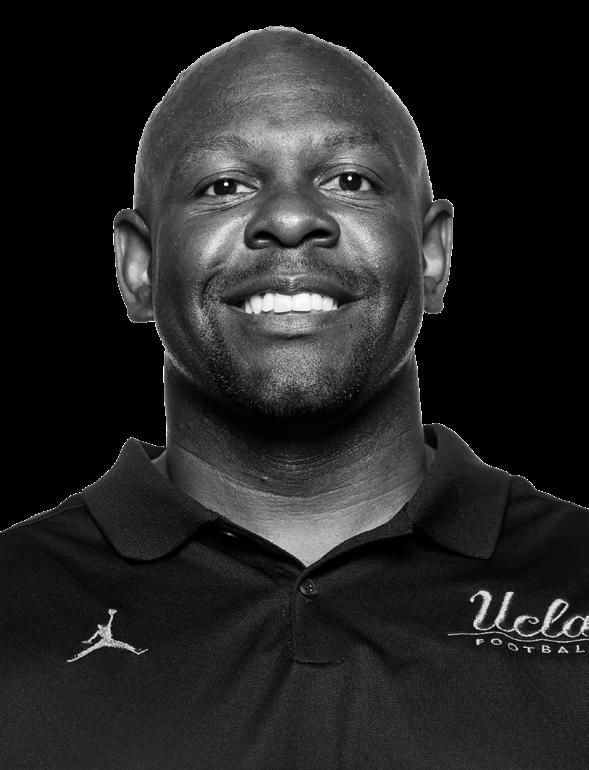
Firing a head coach is a rad ical decision, but one that has so far worked out in UCLA’s favor over the past couple of weeks. One thing can be certain though that this change in coaching has reignited some thing within UCLA’s program that hasn’t been there before. Time will tell if this success will be sustained or if other teams will adapt and react accordingly to stifle UCLA football.
Kira Willinger Staff Writer
This school year, the Independent Study Physical Education (ISPE) requirements for Samo have been modified, which has resulted in stricter criteria. ISPE is a program that offers rigorous student athletes the chance to acquire their PE credit outside of school practice, training and competitions.
This program is for students who aren’t already active in a school sport. While Samo offers a myriad of sports, ISPE is a need for students who participate in a sport outside of school that isn’t offered at Samo, like ice-skating. That way, these students can receive their full PE credit without having to do a general PE class on top of the practice they already have. This
documentation of a specific number of hours of physical activity per week is required. The amount of hours of physical activity needed per week was originally a little bit over three hours, but has increased to seven and a half hours. The initial proposal was to increase the number of hours to 10, but after much debate, the Santa Monica-Malibu Unified School District (SMMUSD) decided 10 hours may be too big a shift for some students. Multiple SMMUSD board members think that the increase in hours is a positive addition to the criteria, like Dr. Ashley Benjamin, SMMUSD’s Director of Curriculum and Instruction.
“ISPE is for the student who is competing and training like their peer counterpart who is on a competitive team on campus,” Benjamin said. “A novice trying out a program is not equivalent to a high school competitive athlete, where athletes are training up to 13 hours per week plus games.”

Various students have expressed their feelings about the increase in required hours. Annelise Sebastian (’28), a member of ISPE who practices taekwondo, shared her perspective on why she believes the increase in hours is an unjust decision.
“Honestly, I feel it’s a little unfair. Even though people taking sports at Samo may exceed that amount of hours, people in the whole PE group are only doing around four and a half hours of PE per week,” Sebastian said. “I feel like me personally, I took ISPE as a replacement for PE, so I could fill my class for another academic, or fill my schedule with another academic class. Therefore, I would have a lot more work than the average student taking PE.”
Xylia Criswell (’26), a student-athlete at Samo on the varsity girls’ water polo team, shared a different perspective on how the
new change might be fair compared to students in PE and student-athletes.
“I do think it’s a just decision, it’s interesting because from the PE perspective, if you were in regular PE, you would be doing more than three hours a week of that,” Criswell said. “From the water polo perspective, when we’re in season, we have up to 14 hours a week of training. That’s almost double seven and a half, which makes seven and a half seem even more just.”
Eligibility for being accepted to the program has become tighter. ISPE is now solely for extremely competitive sports, whereas recreational sports, such as badminton or hiking, aren’t included in the ISPE criteria anymore.
Additionally, students applying to ISPE need to be highly ranked in their sports program. The type of programs that meet the ISPE criteria include preparation programs for State, National, Regional, or Olympic level competitions. Moreover, Micah Zund (’28), an active rock climber who participates in ISPE, raised a point on his belief that the requirement for sports with competitions isn’t ethical.
“It’s a little bit much, especially for some sports. They don’t have as many competitions, and their competition season is short. Like, if people are doing martial arts, there aren’t too many competitions. Rock climbing season is only for a couple of months,” Zund said.
While some students view the new regulations as unfair, the ISPE program stresses that the point of ISPE is to further advance elite student athletes toward their futures and that these modifications are ultimately for the benefit of students.
thesamohinews@gmail.com
Leo Mooney Sports Reporter
On Oct. 21, the National Basketball Association (NBA) kicked off its 80th season, in what will be one of the most highly anticipated ones yet. With offseason trades, college superstars turning pro, and veterans chasing a long-awaited championship, the league has undergone major changes.
The league is split up into two conferences, the East and the West. In each conference, there are three smaller divisions with five teams each. In total, the league has 30 teams that play 82 games from October to May. The NBA playoffs are a four-round tournament where 16 teams (with eight from each conference) compete for the championship.
In the 2024-2025 season, the Oklahoma City Thunder won the championship against the Indiana Pacers in dominant fashion. They were led by the Most Valuable Player (MVP) of the league, Shai Gilgius Alexander. According to Sports Illustrated, they are considered the favorites this year to win the title again. Other favorites for this season include the Cleveland Cavaliers, New York Knicks and Denver Nuggets.
This year, two of the biggest stories in the NBA take place right here in LA. Both the LA Clippers and the LA Lakers have made headlines during this offseason, but for two very different reasons. The Los Angeles Lakers have been in the spotlight throughout the whole summer. Star player Luka Doncic got traded to the Lakers on Feb. 2, 2025 - about halfway through last season. The star duo of Lebron James and Doncic played well last season, leading the team into the playoffs. However, in the playoffs, Doncic was perceived as being out of shape and out of sync. During this off-season he was on a strict regiment, working out twice a day, working on his diet and sharpening his skills. Overall, he lost
about 30 pounds.
Jack Phelan (’28), a basketball player and fan, gave his thoughts on the matter.
“I think he’s going to be faster, quicker on his feet, and better at defense. He will be able to get easy buckets now.” Phelan said. The Lakers hope that this change can help them get over the hump this year and play for a championship.
The other LA team, the Los Angeles Clippers, sparked major controversy that gained prominence in September when the league investigated a no-show endorsement deal for star player Kawhi Leonard. In other words, Kawhi Leonard signed a deal with the company Aspiration, but ultimately didn’t carry out any work for them. Aspiration is now bankrupt, and it allegedly happened as a way to get around the NBA’s salary cap. The Clippers have continued to deny these allegations, but investigations continue. Owner Steve Ballmer has been placed under a lot of scrutiny in these past months, but he too, has continued to deny the allegations.
Even if the allegations don’t amount to anything, this whole ordeal will have a stain on Leonard’s legacy and the way the Clippers are thought of as a whole.
Levi Shank (’28) an avid basketball fanatic, gave his thoughts on the matter.
“Steve Ballmer was paying Kawhi Leonard for a no-show job, under-the-table money. When the NBA finishes their investigation and then decides on its consequences, that could cause Kawhi to either have his contract terminated or he can’t continue playing with the Clippers,” Shank said.
This season marks a turning point in the NBA. It seems that this could be one of the last years for the older generation to make their mark and win a championship. Star players like James, Kev-
in Durant, James Harden, Leonard, Steph Curry and Jimmy Butler are all over 35 years old.
“I think the older players have a chance to go very far in the playoffs, succeed season,”
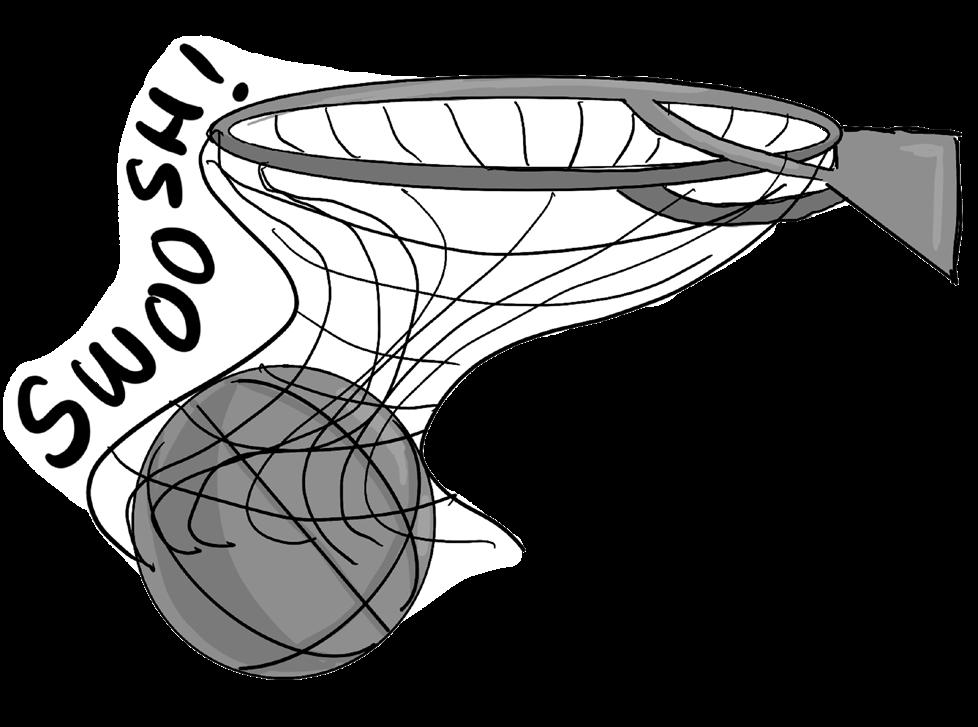
“I can assure you, no player has trained like I did this summer. I feel better and I look stronger.” Wembanyama said.
In the 2024 draft, player Cooper Flagg was the number one draft pick by the Dallas Mavericks. Flagg is one of the most highly anticipated rookies the league has ever seen. With his skills and size, he has the tools to perform at a high level in the NBA. With all these major changes coming to the NBA, many are anticipating an interesting season ahead. JJ Reddick, a former NBA player who is now an analyst, gave his thoughts on the start of the NBA season.
“This is the most excited I’ve been for a regular season, period. An NBA season, period,” Reddick said.
Art by Florence Fraiser-Macduff
Sophia Friedman Staff Writer
In the 2025 World Series, the Los Angeles Dodgers face the Toronto Blue Jays, the current standings being 2-3 respectively. Returning as the defending champions, the Dodgers hope to best the Blue Jays, who are making their first World Series appearance since 1993. The matchup has brought a lot of excitement and competition to the field, with the teams neck-andneck as one tries to come out as World Series champion.
The Dodgers faced a lot of competition on their way to the series.
On Oct. 9th, the Dodgers arose as victors against the Philadelphia Phillies in a close 2-1 game to win the National League Division Series. This win secured their spot in the league championship against the Milwaukee Brewers, where they could eventually advance to the World Series.
Taking place at Dodger Stadium, the showdown against the Phillies lasted 3 hours and 41 minutes. The first six innings were tight, and remained scoreless. At the top of the seventh inning, batter Nick Castellanos was able to hit after his second strike. Castellanos hit a two-base hit, where he barely slid into second base. This allowed for runner Max Kepler of the Phillies to run through home base, putting the first home-run on the score. This run was matched by the Dodgers at the bottom of the seventh inning, scored by Justin Dean.
The game continued into the eleventh inning, ending in a dramatic walk-off by runner Hyeseong was caused by an error the Phillies’ pitcher, which allowed Kim to run into home base for the game-winning Ryan member boys team, says, was my of the game.

I got really In this year’s Dodgers’ record has been 93-69. Right won seven establishing as defending World Series champions. continued the season and the Nation League title for the season in a The played their toughest games of the season against the Milwaukee Brewers. The last time they played was during the regular season, where the Milwaukee Brewers dominated against the Dodgers in a six-game sweep. On Oct. 13, the Dodgers took their first series lead against the Brewers. After five scoreless innings, Freddie Freedman of the Dodgers had a solo home run, putting the first point on the
scoreboard for the Dodgers and the second point being put on by Mookie Betts, securing the win for the Dodgers.
On Oct. 14, the Dodgers secured their second win in the series, besting the Brewers 5-1 at Milwaukee. At the bottom of the first inning, Brewers batter Jackson Chourio kicked off the game by hitting a ball out of the park. At the top of the second inning, Dodgers batter Teoscar Hernandez hit a solo home run in the same fashion as the former, bringing the Dodgers into the game. Shortly after, Enrique Hernandez made it to home plate. At the top of the sixth, Max Muncy of the Dodgers makes a home run after hitting a fly ball to center field. Andy Pages wrapped up the game in the eighth inning, bringing the Dodgers 2-0 in the series.
“Our bullpen is really strong, especially with Yoshinobu Yamamoto and Roki Sasaki coming back from an injury.” says Vasquez (’28), after Yamamoto pitched nine innings for the Dodgers in their second game against the Brewers.
On Oct. 16, the Dodgers continued their winning streak against the Brewers, making them 3-0 in the series. The Dodgers ended with a 3-1 win. Kicking off the first inning, Shohei Ohtani of the Dodgers scored the first home run of the game. The Brewers put up a fight in the second inning, when Caleb Durbin made it to home and evened out the score. The sixth inning was especially exciting for the Dodgers, as Will Smith and Freedman both scored and ensured the Dodger’s third win in the seven-game series.
“I’m really happy with how they’ve been doing because they lost every game against the Brewers in the regular season, so people thought we were going to lose but I’m glad we’re doing well.” says Chapman (’29)
On Oct. 17, the Dodgers completed their four-game sweep against the Brewers, giving them a spot in the World Series. The Dodgers kicked off the start of the game in fierce fashion; Ohtani, Betts, and Smith brought home runs for the Dodgers. Ohtani also scored in the fourth and seventh inning, playing an outstanding game. The Brewers tried to fight back in the eighth inning when Durbin scored, but it wasn’t nearly enough to out beat the Dodgers. Not only did Ohtani hit three home runs, his pitching was outmatched. During six scoreless innings, Ohtani struck out ten Brewers batters. His performance made him MVP, and the first player to achieve that statistical combination in a game. So far, the competition between the Dodgers and Blue Jays has been extremely tight, with long games and close scores.
The rest of the series remains uncertain, as each team fights to obtain the World Series title. The following games are set to be on Oct. 31 and Nov. 1. in Toronto.
thesamohinews@gmail.com
The World Cup, the biggest and most prestigious international soccer tournament is coming to LA in summer of 2026. Every four years, 38 teams from across the world come together to compete in this month’s long tournament, the most watched event in the world. The World Cup is currently facing controversy for its ticketing in this upcoming LA tournament as a result of its high prices and complex systems of ticket release. The World Cup, organized by the International Federation of Association Football (FIFA), has been a landmark in sporting history since its beginning in 1930 and has risen to become the biggest recurring event in history. In the years before each cup, qualifying rounds select the main 38 teams featured to play, with the 2026 Cup adding an additional ten teams, bringing the total number competing up to 48. After this qualifying round, the selected teams move to the group stage in which they are sectioned into groups of four with two teams advancing to a knockout stage. From the knockout stage onwards, the tournament functions in a standard bracket style with teams competing for the top 3 spots. This year, the tournament will take place across 16 North American cities, with eight of the matches taking place here in Los Angeles. For fans in the L.A. area to attend the matches, it has become an elaborate exercise to secure a ticket, at least one at a reasonable price. The initial tickets for nosebleeds in the lowest level match would run 560 dollars which doesn’t take into account more important matches or a better view of the game itself.
Ashley Tan Staff Writer
In their 136th season, the Los Angeles Dodgers won their division, National League West, and have had many dramatic victories. Contrasting with the excitement surrounding these wins are the social crises that have recently plagued the team’s home city, including the widespread detainment of immigrants and the Pacific Palisades fires. In times of crises, Dodger Stadium, along with its network of foundations, has been a common place for L.A. residents to feel a sense of belonging. With eight world series championships, and a long going rivalry with the San Francisco Giants, the team has fostered the develop ment of a passionate and diverse fanbase that has a community its own. This has been a key aspect of L.A.’s culture since its estab lishment in the city in 1958. On Sept. 8 the Supreme Court lifted restrictions that barred the Trump Administration from having Immi gration and Customs Enforcement (ICE) raids in Los Angeles. In response, thousands of LA residents took part in the recent No Kings Protest on Oct. 18, which was one in a series of many other protests across the nation. Samo students such as Rian Barenfeld (’26) who attended the protest recall seeing many Dodgers fans, showing how the sports team plays a key role in unifying the LA community, even in political resistance. “There were many Dodgers fans at the protest, [and] many people had on the bright blue Dodgers hats and jerseys,” Barenfeld said. “It showed how the team’s fan base reflects the heart of LA. There were even people chanting ‘Go Dodgers.’” Amid public outrage and resistance to the detainment of immigrants in the city, the Dodgers organization claimed that they denied entry to ICE agents that requested entry to the Dodger Stadium parking lots. The organization faced much pressure to take action from their fan base, which is 40 percent Latino. Along with this, 10 out of 26 players in their 2025 Opening Day roster were born outside the US. In June, Kike Hernandez, a Puerto Rican outfield -
er for the Dodgers, spoke out against ICE in an instagram post, criticizing the the agency for ripping apart the city. Additionally, a $1 million donation was made by the organization to groups that aid immigrants that have been negatively impacted by ICE raids in Los Angeles. Kids 4 Dodgers, another community program run by Los Angeles Dodgers Foundation (LADF), provides free tickets, transportation and meals, to youth organizations and schools. The program not only gives underprivileged youth the opportunity to attend a Dodgers game, but it connects them to the Dodgers community.

Along with their standings on immigration enforcement, the Dodgers organization and their partner organizations participated in relief efforts for the Pacific Palisades fire. With other sports teams, LADF pledged eight million dollars to several non profit organizations, including American Red Cross and the Los Angeles Fire Foundation. The fire destroyed over 6,800 structures and displaced thousands of people in the area in January. An online auction with items from star players was held after the fires, with all proceeds going to non-profits that served communities displaced by the wildfires. These relief efforts included distributing essentials, reconstructing youth baseball fields and supporting community recovery funds. One major community program created by LADF, Dodgers Dreamfields, has the purpose of giving low-income families safe places to play baseball and softball. The foundation rebuilt Loma Alta Park in Altadena, making the two Dodgers Dreamfields the first park to reopen in the area after the detrimental aftermath of the fires. Amidst its myriad of civic aid efforts, LADF reminds the L.A. community that sports is more than just entertainment. Going beyond competition and championship trophies, athletics have the rare and powerful ability to bring people together and support those in need.
thesamohinews@gmail.com
The only direct way to get tickets is through either a VISA or Verizon presale, which is a lottery system where members can apply into the drawing. If they are neither a Verizon member or Visa card holder and are not chosen in the lottery, fans can try a later ticket draw and a random selection draw before the tickets are widely released on a first-come first-served basis. Dynamic pricing used by FIFA alters tickets based on the expected popularity of each match to increase the baseline ticket price. Instead of a set price for certain matches or seats, popularity factors change the tickets and make them exponentially more expensive. With this dynamic pricing, starting prices of tickets for more average games are in the hundreds with the finals going for over $6500. Even with this steep price tag, the competitiveness to get the tickets will make them hard to acquire. Special ways to get tickets like ‘Right to Buy’ tokens give fans better security in buying their ticket with an increased price tag. For hundreds of dollars, you can buy one of these RTB tokens to have first access to tickets when they go on sale. For the more important matches, like the finals, these tokens have a starting price of $999. It is important to note that the price spent to gain access to the match tickets is not put towards the ticket price themselves. In other words, people who have spent upwards of a thousand dollars to get a token to ensure they could buy tickets will still have to pay full price for tickets once they go on sale. In addition, FIFA has recently announced that only the most expensive categories of tickets would be available to RTB token holders, not giving them complete access to the tickets.
Many had already bought the tokens under the assumption that they could use them to buy affordable tickets, an opportunity no longer exists. While the sport of soccer is widely enjoyed throughout the world, it seems that these steep ticket prices will vastly influence the way the in-person audience is formed at next year’s event. The complicated rounds of pre-sale in addition to the large price is shaping the audience to be one of wealth and making exclusivity play a large factor in whether or not fans are able to obtain their tickets. Looking at the individual level, one student trying to acquire tickets, Diego Olivera (’26), shares his views on the upcoming World Cup.
“It’s overcrowded. People are gonna try to hop the gate,” Olivera states. “The prices are also too high, people aren’t going to want to pay it, so they’d rather take the risk and try to hop anything that they could to get in.” In all, the state of ticketing for the World Cup is in a unique place, with genuine fans going through a convoluted process to try getting the most reasonable of available tickets and those with money being able to bypass the system nearly entirely. Looking towards the future of the World Cup, it is hard to ignore how the ticketing in the upcoming tournament will affect those able to enjoy the experience going forward. It seems that the ability to attend the games, as an average fan, is becoming increasingly out of reach, becoming skewed towards the wealthy and those who could meet the exclusive criteria set by FIFA.
thesamohinews@gmail.com
team a spot in CIF (California Interscholastic Federation.
The Samo Girls’ Volleyball team has continued to thrive off of their successful start of the season. They are now 16-9 in overall play, and a dominant 8-1 in Ocean League play. On Wednesday, the team secured first place in the Ocean League against Culver City.
Outside hitter, Maya Paysinger (’27), talked about the Culver City game.
“It went really well. I think that our momentum and energy really pushed us through that game, and we really wanted to win.” Paysinger said.
Samo won in three straight sets to win league championships. The team has now won Ocean league two years in a row, which is a huge accomplishment, considering the tough competition. Being the champions of the Ocean League, it secured the
A big piece of this success is tied back to their new head coach, Jonathon Pritchard. He recently talked about his experience as a coach for the team.
“This is my first year as the Varsity head coach and 4th year coaching Samohi Girls Volleyball. I have loved every minute of it! There have been many challenges and learning moments, but I am grateful for the opportunity to coach this amazing group of student-athletes.” Pritchard said.
The team had a rough stretch, losing three straight games on Oct. 3 during a tournament in Los Angeles. They rebounded and won five of their last six games.
“I’ve learned that even when we’re down, we know we can come back, if we all play together,” Paysinger said.
Coach Pritchard agrees, saying the strengths of this team.
“This team, from top to bot -
tom, is composed of hardworking individuals who prioritize the team above all else. Their biggest strengths are work ethic, coachability, and team camaraderie. I do not believe this team has any standout weaknesses.” Pritchard said
With the team coming off 4 straight wins they had high expectations going into CIF, yet they lost the first round.
The first CIF match was on Wed, Oct. 22, against Polytechnic High School. To prepare for this game, the team watched tape and studied Polytechnic’s game plan and previous games. Despite preparing well for this game, the team lost in a closely contested game that went to five sets. Even though they lost, the team is still proud of the performance that they put forth.
Laila Ghaffari (‘28), a setter on the team, talked about the game.
“It was a tight game that we lost in five sets, but we played real -
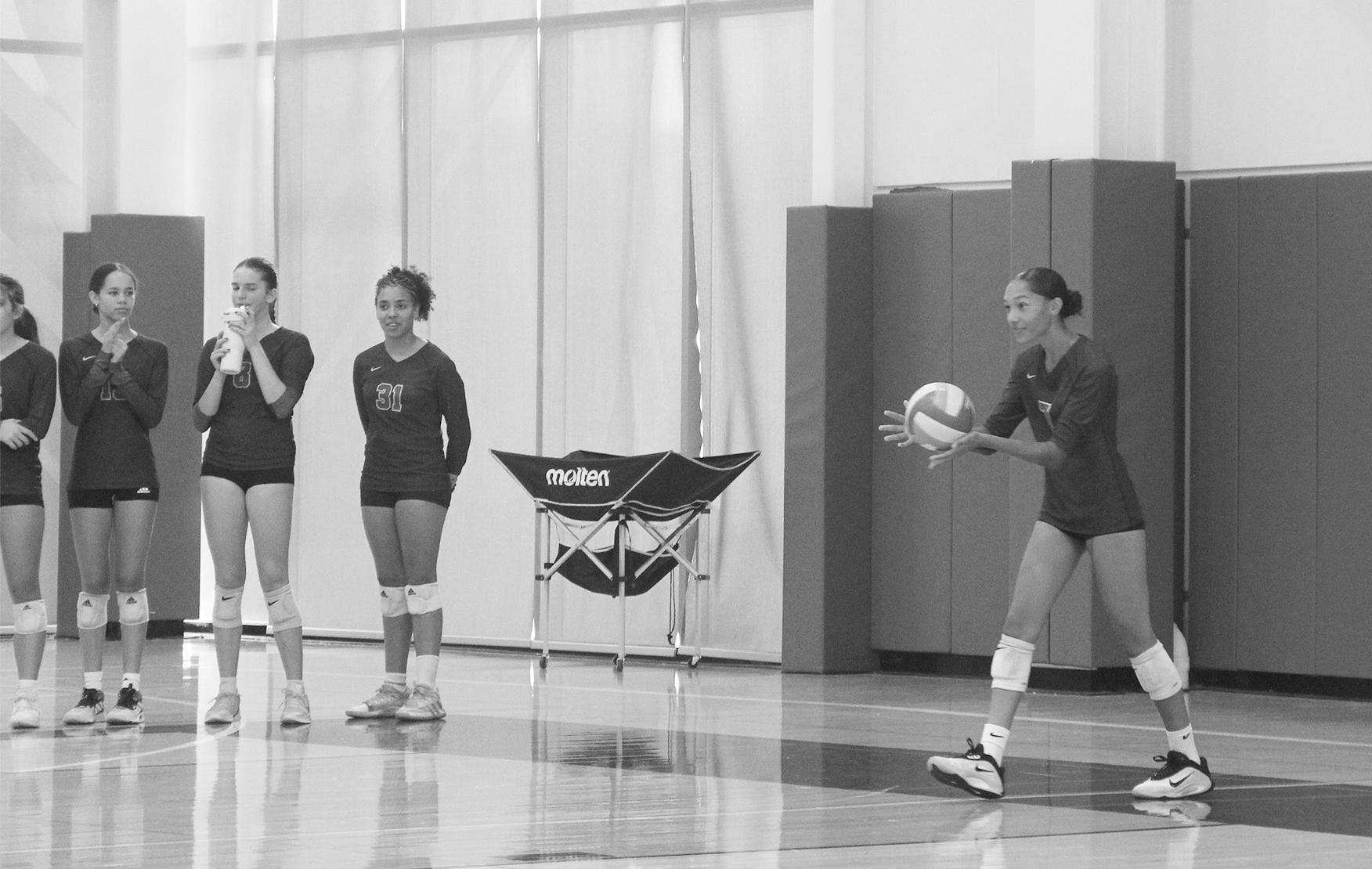
ly well, and we were really tight with them.” Ghaffari (‘28) said.
Although the season is over, the team has taken many lessons from it and will use them next year to try and improve upon a successful fall. Ghaffari (‘28) summed up the ups and downs of the season.
score of 215-227 for their final game of the season.

The overall Seaon record reflects challenges, two notable wins this season signal the girls’ golf team’s commitment to maximize their performance. On
Oct. 7 and 9, the girls faced West Torrance, resulting in scores of 244-198 and 247-225.
On Oct. 15, they sealed the win against El Segundo, coming to a
According to co-captain Ophelia Harvey (’27), this is the first time she has seen the team achieve two wins in a single season. Harvey expressed her aspirations for the team’s future, focusing on embracing team unity and advancing the skills of each player. She emphasized the progress already made in these areas. While acknowledging the challenges of conducting team gatherings with a large roster of over 20 players, Harvey remains committed to organizing more activities for the girls in the future.
The encouragement from the team was something co-captain Tully Pond (’27) paid attention to. Pond highlighted the importance of the team’s supportive energy, explaining that their camaraderie was a defining component of their performance on the course. Both co-captains agree that maintaining team harmony
and fostering mutual upliftment are their highest priorities.
Team captain Frances Aguilar (’26), played her last season with the team. The bittersweet moment of the season ending put into perspective what she hopes the team continues to do in the future.
“Teamwork, compassion, work ethic, kindness. As a team, sure, you want to win. But if you don’t like your teammates and you aren’t having a good time, there’s no point in being there. So, as long as they continue having fun [playing], that’s all I could hope for them,” Aguilar said.
Aguilar’s passion for the sport especially stands out when she explains that going to CIF qualifiers again was less about winning and more about the opportunity to play with other girls who love golf and have a good time while doing it. Aguilar didn’t make it through the qualifying round, but that wasn’t a problem for her.
“I don’t think I played my best,
With a flawless 7-0 league record, the Samo girls’ flag football team emerged victorious from their game against Inglewood High School, crowning them Ocean League champions for the third year in a row. The game was full of energy with fastpaced runs and throws, showing the team’s chemistry on the field. As the team reflects on their win, they are starting their journey to the California Interscholastic Federation (CIF) playoffs. Freya Rainsford (’28) expressed her excitement on the win and the team’s plan for the road ahead, “It feels great to see that all of our hard work and our determination to win for the third year in a row all built up… now we’re just preparing ourselves for CIF, and hopefully be back-to-back CIF champions,” Rainsford said.
Much of the team’s success comes from their secure bond and disciplined practices. Whether it’s watching film or practicing after school, the team pushes each other to improve every day. The girls are on a winning streak like last year, on the same path to CIF. The team’s plan is to win playoffs again, building off of all the hard work that the team has put in this season.
In the previous season, beyond physical training, the girls focused on communication, teamwork and staying mentally tough through each game. Their steady rhythm has helped them throughout the season, and will continue to help them keep steady through playoffs. Kalea Oshidari (’26) describes how the flag football team continued doing their very best, especially when stakes got high and opponents got stronger.
“I think it was a lot of just sticking to our own principles and continuing to play our own game when we were playing against different competition,” Oshidari said.
Head Coach Lambert expressed his pride in the team’s continued success and motivation to keep pushing forward.
“It’s very fulfilling to see that our girls can enter the game and then go ahead and chase big things again, like another Ocean League,” Lambert said.
Playoffs occurred on Oct. 21st and the girls’ team lost 0-21, ending their season and not being able to attain the CIF title. x
“I’m really proud of my team and everything we’ve accomplished this season. … I’m proud that everyone’s able to step up and do their part to continue our legacy of having undefeated Ocean League champions,” Chloe Sanders (26’) said.
“We moved up divisions. So it was expected that the competition was gonna be harder when we went into CIF, but we also won the Ocean League. As a team, we advanced a lot,” Ghaffari (‘28) said.
but honestly, it was just a fun experience. I got to play with the same kind of girls I was playing with during league, which is always really fun. Just being able to be out there and play with people whom I enjoy being with is just a gift in itself. It really didn’t matter that I didn’t qualify,” Aguilar said.
This season, the team welcomed a new coach, who happens to be the father of two team members. Jay Pond carried out his first coaching experience with the Samo girls’ golf team, saying that he treats them all like family. As far as motivation goes, Coach Jay said that the girls have it within themselves already to perform to the best of their abilities.
“[Having two daughters on the team] makes me feel closer to the team for sure. I treat them all like my daughters in a funny way. I care for them in that capacity. I want them all to excel,” Coach Jay said.
thesamohinewsr@gmail.com

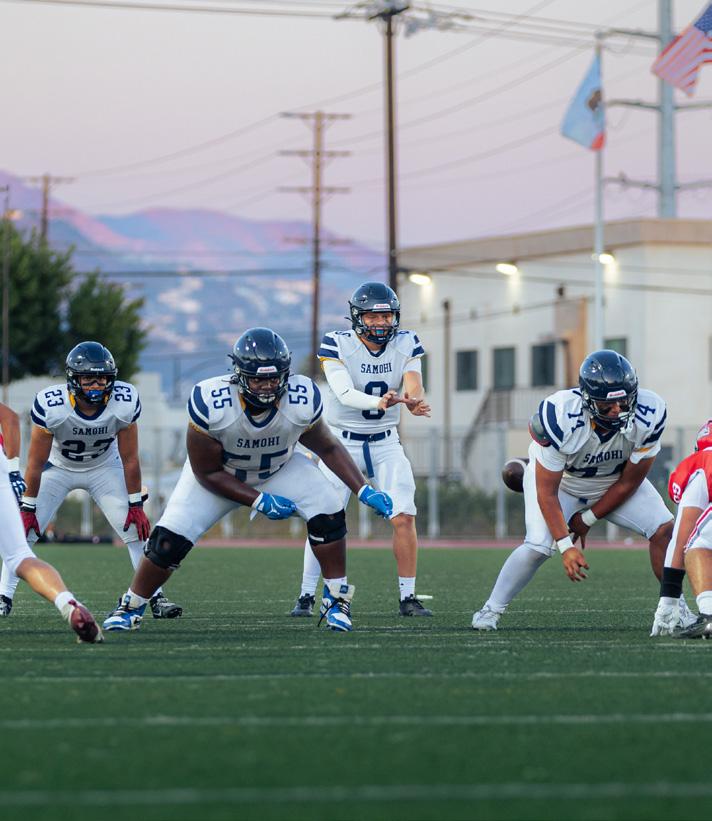
With one more league game in the season, the Samo football team has a balanced record of 2-2. Samo looks promising going into playoffs and has hopes to make a good run for the California Interscholastic Federation (CIF) Championship. The Vikings have shown growth this season, already doing better than last year’s 1-4 league record.
With a 5-4 overall record, football has been pulling ahead of their competition The Vikings currently hold a league record of 2-2, having won their home game 21-13 against North Torrance High School on Oct. 3. They also won the homecoming game against South Torrance High School on Oct. 10, which featured a big comeback in the last quarter, resulting in a 42-37 victory.
The team does not view recently suffered losses against both Redondo Union High School and Torrance High School as discounting their earlier victories. Having already had a few big comebacks this season, starting quarterback Eliot Bingener (’26) expressed his pride in the team’s ability to push
through challenges this season.
“I think just finishing games, not quitting when we’re down, and just practicing hard,” Bingener said.
Endurance and persistence have seemed to be the Vikings key to success this season. Head coach Carter Paysinger talked about how the team’s strong points this season are their ability to persevere through games and not give up until it’s over.

“We fell behind in a couple of games, and the whole attitude of the team is it’s not over until it’s over. They just understand we play until the last whistle blows,” Paysinger said. “I think that it’s important to know that [...] just like in any other sport, you’re gonna have ups and downs, and to be able to play through those ups and downs is key.”
Samo looks to be in a good spot as they
continue through the league season, hoping to make a strong run through the playoffs too. The Vikings have their last league game on Oct. 31 against Peninsula High School, which will help determine whether or not they qualify for CIF playoffs.
thesamohinews@gmail.com
Samo girls’ tennis continues another successful season. They started off the season with high expectations after winning Ocean League and advancing to the California Interscholastic Federation (CIF) last year. Now with a strong team and some promising new faces, the Samo girls’ tennis team is living up to their expectations.
Currently, Samo girls’ tennis has a record of 11-2, and are the undefeated Ocean League champions, with their last win being against Inglewood High School 17-1. An amazing win to celebrate on Senior Appreciation Day. Head coach Shaun Simone laid out one of their strengths this season
“We are doing really well, better than last year. [..] Doubles is much stronger this year; those six girls are playing really well together.
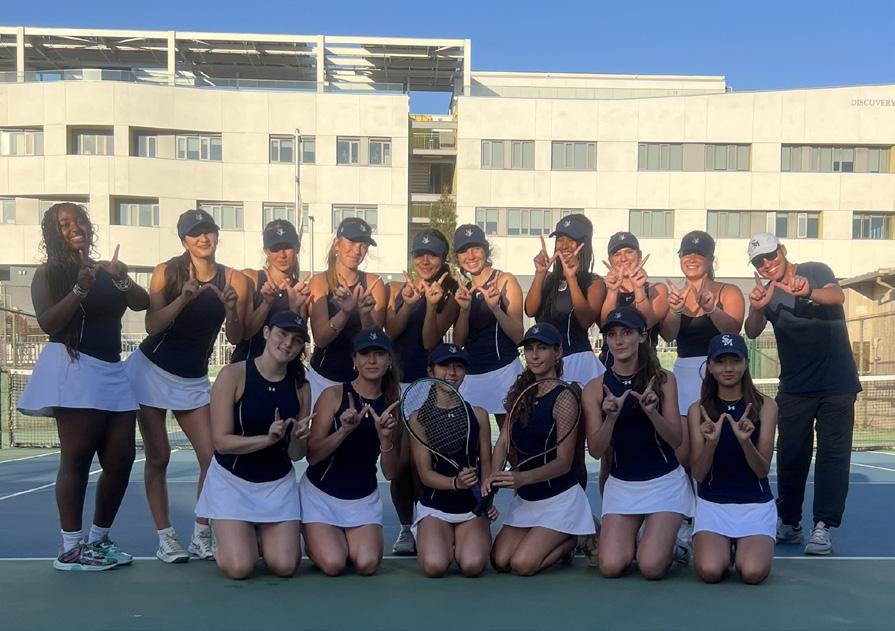
The chemistry and the energy remain high, which is always a delight to see this far into the season.” Simone said.
In their match against Geffen Academy - one of Samo’s biggest competitors - their doubles
teams didn’t lose a single match-up, with second doubles winning 6-0 in every round. In their match against Inglewood High School, Samo’s first and second doubles won each of their matches 6-0. Varsity captain Rebecca Sholze (’26) talked about their team, comparing this season with their previous season.
“We have done a good job of splitting across more people the skill level we have on our team. Last year, it was really one person focused, and this year we have a lot more equal amount of talent.” Scholze said. Not only are the doubles strong this year, but Samo’s singles are also doing very well in their matches. Varsity captain Stella Callen (’26) shares her experience of the season and praises the team.
“The first half of our season was really suc-
cessful this year. We faced some hard competitors and came away with either a victory or having learned something new,” Callen said.
“We have a really strong team this year, I’m really proud of, especially our singles player Ava Brara (’27), who has been on varsity every year she has been here, and of our new freshman, and just of the entire team in general, everyone is doing great.”
In their most recent game against Mira Costa High School, one of their toughest opponents, Brara won all three of her matches. Samo’s team is hard at work winning matches, improving their warmups, and advancing towards league finals and CIFs. With strong players in both singles and doubles and with victories in key matches this year, the team is hopeful about their chances in CIFs. With such an amazing start to the season, the second half is looking very promising for girls’ tennis.
thesamohinews@gmail.com
The boys’ water polo team ended their season on Oct. 30 in round 1 of Division II California Interscholastic Federation (CIF) playoffs against Etiwanda High School. On Oct. 22, the team had their last game of the regular season against Malibu High School, which ended with a 12-7 win. They started off their season strong with their opening home game on Aug. 21, against Notre Dame High School, which ended in a 13-6 win.
The final game of the season, against Etiwanda High School, ended in a 10-11 loss. Throughout each quarter neither team was dominating, with the score continuously being tied or up by one point. Despite the loss, the Vikings had some
key moments, such as when Aras Gedvila (’26) scored in the last seven seconds of the first quarter.
With an overall record of 21-11 and a league record of 3-4, the team continuously dominated in games.
After their sixth home game on Oct. 6 – against Cleveland High School, which resulted in a 17-10 win – head coach Matthew Flanders reflected on the team’s improvement regarding defense and competition.
“We were able to play good defense from the beginning. It was a good step towards qualifying for CIF playoffs,” Flanders said.
The Vikings also faced losses that they were able to learn from.
On Oct. 7, Samo played against
Redondo Union High School, which ended with a final score of 12-15. The game started as a fair competition, but Redondo was able to get a lead on Samo by the end
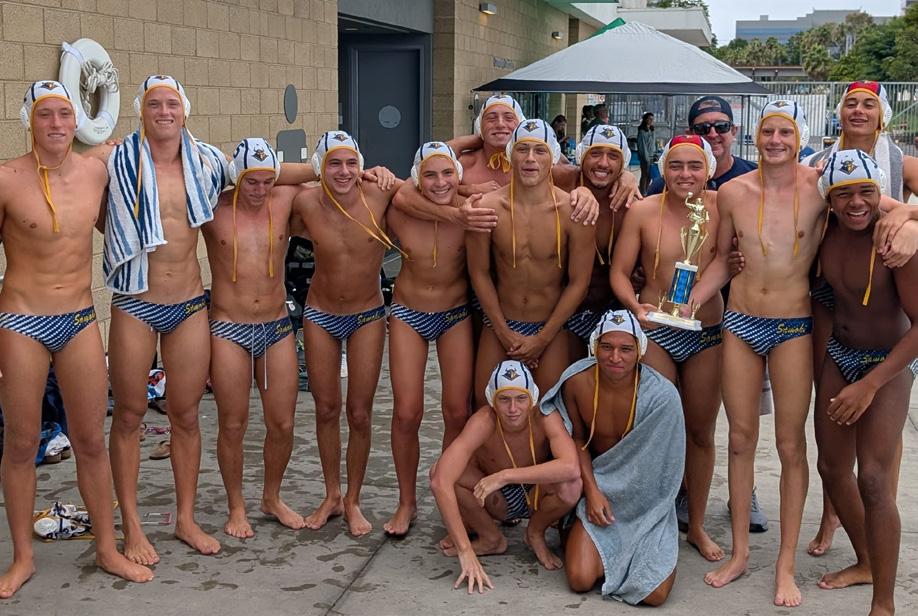
of the second quarter.
Having lost, members of the team such as captain Luc Garland-Di Stefano (’26) felt discouraged, but were still able to reflect on good moments for the team.
“When we were, you know, actively communicating drive passes around the perimeter and then looking for a set–that worked beautifully,” Garland-Di Stefano said. “We need to rag on each other less, like stop getting down on your teammates and kind of stay as one unit instead of a bunch of individuals, just so we play more cohesively.”
While the boys’ water polo team had significant victories throughout their season, their one point loss to Etiwanda High School ended what looked to be a promising run in CIF.
thesamohinews@gmail.com
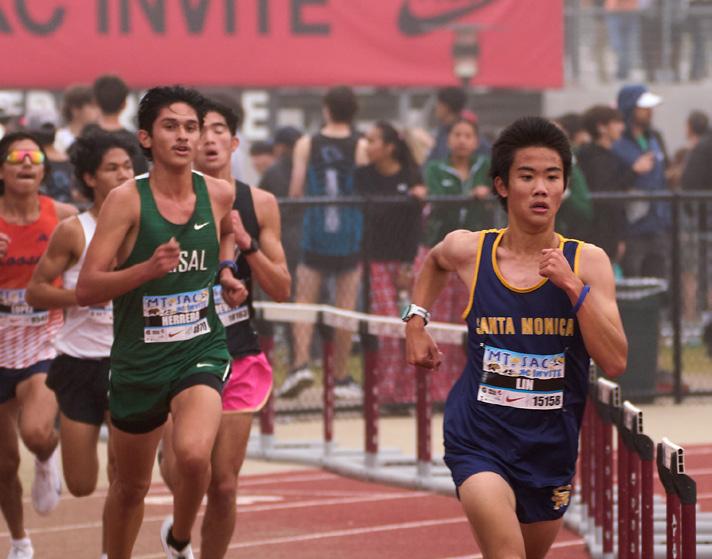
through the season and has been putting in the hours to improve upon where they stood a few months ago. Both the boys’ and girls’ varsity teams are on an upward trajectory and are looking sharp for a chance at state.
At the beginning of this season, varsity made a strong impression by winning their three meets at San Antonio College, Dana Hills High School and Brentwood High School. Those early performances set extremely positive tones for the rest of the season, launching them into success. The Vikings have maintained their momentum and show no signs of slowing down.
So far, the cross-country teams have competed in a total of ten meets. Moving forward, cross country has the Ocean League Finals on Nov. 5, followed by California Interscholastic Federation (CIF) preliminaries and champion-
ships.
Competing in the Clovis International on Oct. 10 and 11 at Woodward Park has given the varsity teams a trial run before running the state meet in a few weeks time. Since state is also held at Woodward Park, the participants of this meet were able to experience what they’re hoping to do, when it really counts in November.
Girls’ varsity runner Crystal Gaitan (’26) explained Clovis International as the most beautiful course she’s ever run. Gaitan explained the course as challenging with lots of hills, but worth it as it gave her a preview of what state is going to be like.
Gaitan also gave insights as to how the team is preparing for state after having run Clovis International.
“Last Saturday, we did a workout in Adelaide
Hills near the Totem Pole and did seven miles of hills. We have also been doing hills near Marine Street,” Gaitan said.
The assistant coach, Katherine Saunders, gave great insight into what the team is going through leading up to finals.
“There have been some complicated moments lately. But all in all, I think that we have a lot of faith in our varsity, and that there’s a kind of excitement brewing under the surface about us being able to take our best, to go do their best and be the best we’ve ever had. So far so good,” Saunders said.
As Samo’s cross-country team nears the end of their season, tension builds, but the team remains positive. They continue to stay focused, confident and ready to finish strong. The time leading up to the team’s final performance has become a true nail-biter.